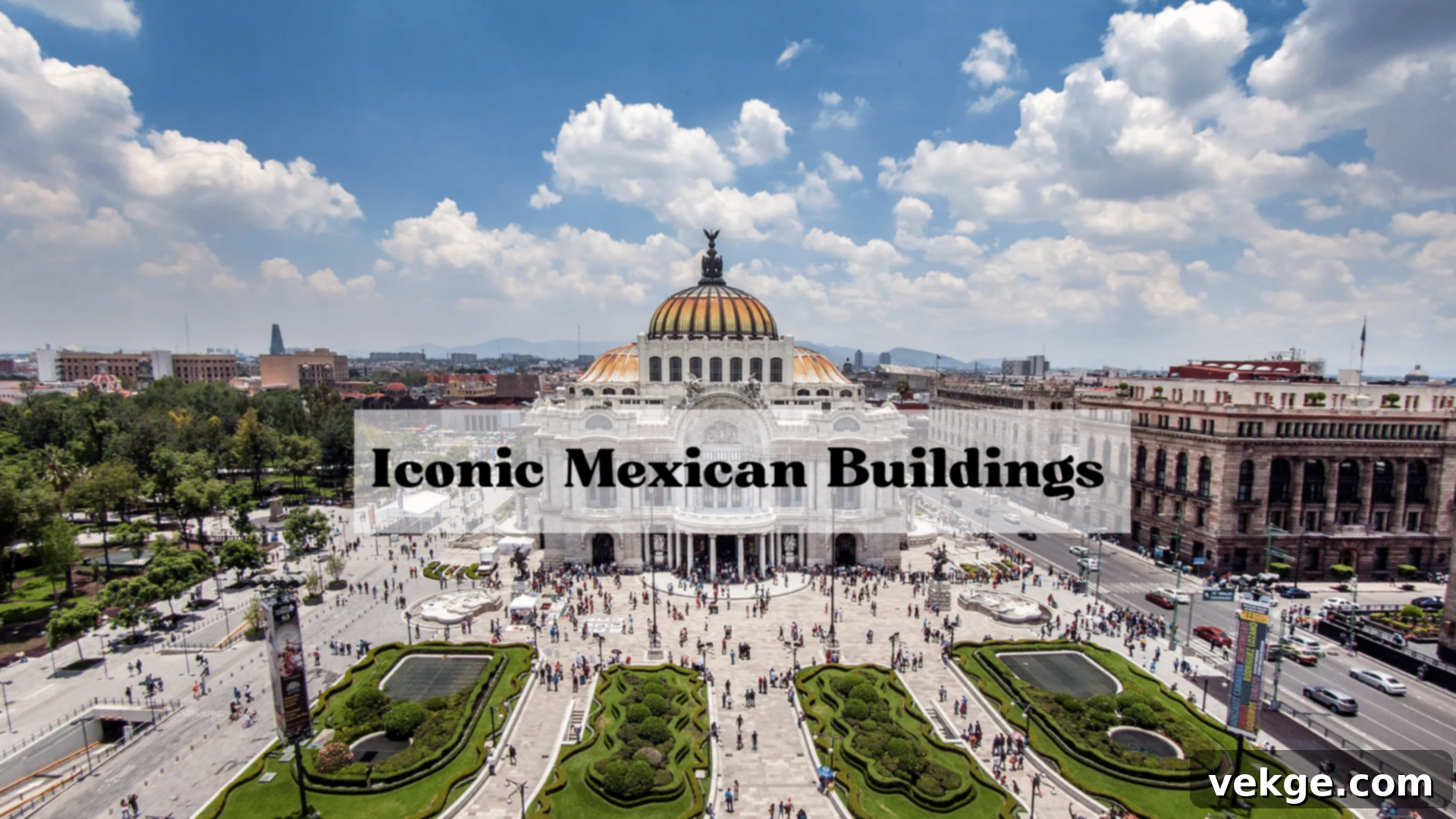The Enduring Splendor: A Deep Dive into Mexico’s Iconic Architecture
Mexico offers an extraordinary and captivating range of architectural styles, a vibrant tapestry woven across centuries of profound cultural evolution. From the mystifying ancient Mayan temples that whisper tales of forgotten civilizations to the awe-inspiring Spanish colonial churches adorned with intricate details, and the bold, innovative statements of modern design, each structure stands as a testament to a unique moment in the nation’s rich history.
Mexican buildings are much more than mere constructions; they are eloquent expressions of design mastery, cultural adaptation, and an intrinsic understanding of diverse environments and evolving social needs. The harmonious fusion of ingenious indigenous techniques with the powerful influences brought by European settlers birthed distinctive and unparalleled styles. These styles have not only shaped Mexico’s landscape but continue to inspire and influence construction and design philosophies worldwide.
This comprehensive article embarks on a journey through Mexico’s most notable structures, spanning different historical periods and diverse regions. We will highlight how these architectural marvels eloquently articulate the identity, beliefs, and aspirations of their respective communities. Through an intimate exploration of these buildings, we gain invaluable insight into Mexico’s deeply rich cultural heritage and its ongoing, significant contribution to global architectural traditions, making it a pivotal player in the world of design.
Major Architectural Styles Shaping Mexico’s Landscape
The architectural narrative of Mexico is profoundly shaped by distinct traditions, each reflecting the nation’s complex history, cultural amalgamation, and the unique characteristics of different time periods. Understanding these styles is key to appreciating the country’s diverse built environment.
Colonial Architecture: A Legacy of Grandeur
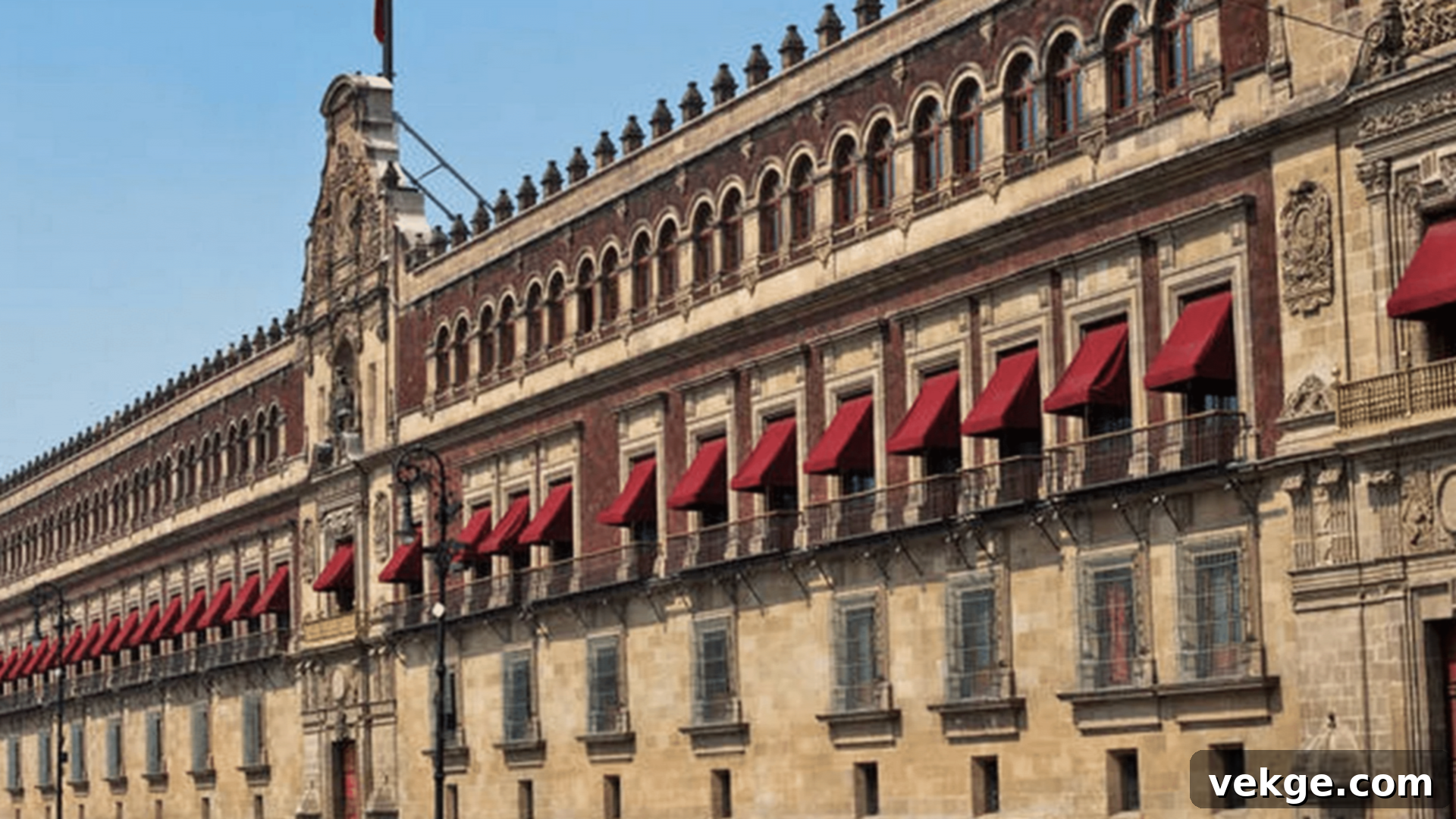
The arrival of the Spanish in the 16th century dramatically transformed Mexico’s urban and rural landscapes. Spanish colonial architecture, characterized by its imposing presence and elaborate ornamentation, became the dominant style. These buildings typically feature robust, thick walls, often constructed from local materials like tezontle (a reddish volcanic stone) and cantera (quarry stone), providing both structural integrity and protection against the elements.
Central courtyards, known as patios, served as the heart of homes and public buildings, offering privacy, ventilation, and a connection to nature. Ornate facades, often in Baroque or Churrigueresque styles, showcased intricate stonework, sculptures, and religious symbolism, reflecting the fervent religious devotion of the era. Mexico City’s magnificent Metropolitan Cathedral, a monumental structure built over centuries, and the numerous exquisite churches found throughout Puebla, exemplify this grand style with their impressive proportions, detailed altarpieces, and masterfully carved stonework. These structures were not just places of worship but symbols of power and cultural dominance, often incorporating indigenous labor and artistic flair.
Traditional Mexican Architecture: Rooted in the Land

Beyond the grandeur of colonial structures, traditional Mexican architecture evolved in direct response to local environments, available resources, and community needs. This style emphasizes practicality, sustainability, and a deep connection to the land. Adobe homes, with their iconic earth-toned walls, are ubiquitous in rural areas. Adobe bricks, made from sun-dried earth, offer exceptional thermal properties, keeping interiors cool in hot climates and warm in cooler seasons, a testament to ancient building wisdom.
Haciendas, once sprawling agricultural estates, represent another significant traditional form. These complexes often combined functional elements like production facilities with grand residential quarters, featuring expansive courtyards, arcaded corridors, and a distinct regional character. These buildings, whether humble adobe dwellings or expansive haciendas, vividly reflect Mexican family life and community values, emphasizing open spaces, communal areas, and an organic connection to the surrounding natural landscape. They embody a way of life intrinsically linked to Mexico’s diverse geography and history.
Modern Mexican Architecture: Innovation and Identity
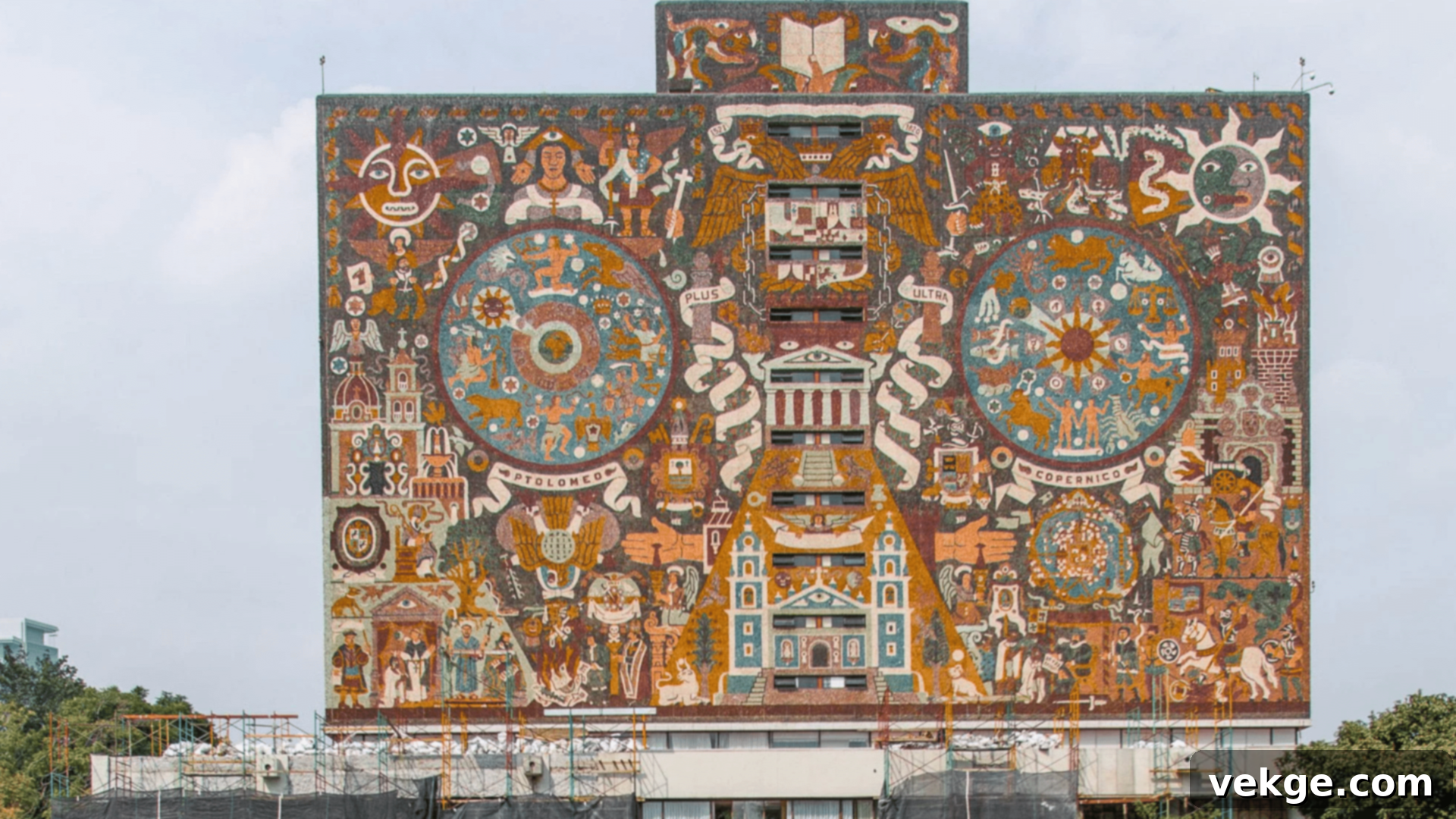
The 20th century heralded a new era for Mexican design, bringing fresh perspectives and innovative approaches that sought to define a modern Mexican identity. Visionary architects like Luis Barragán and Pedro Ramírez Vázquez emerged as pioneers, introducing bold colors, clean lines, and innovative uses of materials, particularly concrete forms. Modern Mexican buildings frequently achieve a harmonious blend of international modernist concepts with profound cultural references, creating a distinctive aesthetic.
A prime example of this synthesis is Mexico City’s iconic National Museum of Anthropology, designed by Ramírez Vázquez, which masterfully integrates pre-Hispanic architectural elements into a contemporary structure. Similarly, the sprawling campus of the National Autonomous University of Mexico (UNAM), a UNESCO World Heritage site, showcases monumental murals, functionalist design, and a unique integration of art and architecture, reflecting a powerful nationalistic sentiment and a commitment to education and culture. These modern masterpieces demonstrate Mexico’s ability to innovate while remaining deeply rooted in its rich artistic and historical legacy.
Iconic Mexican Buildings You Must Know: Architectural Masterpieces
Mexico’s architectural landscape is a captivating blend of historical depth and creative vision, featuring structures that vividly capture different eras of the nation’s dynamic development. From ancient wonders to modern marvels, these buildings tell the story of Mexico.
1. Palacio Postal (Postal Palace), Mexico City
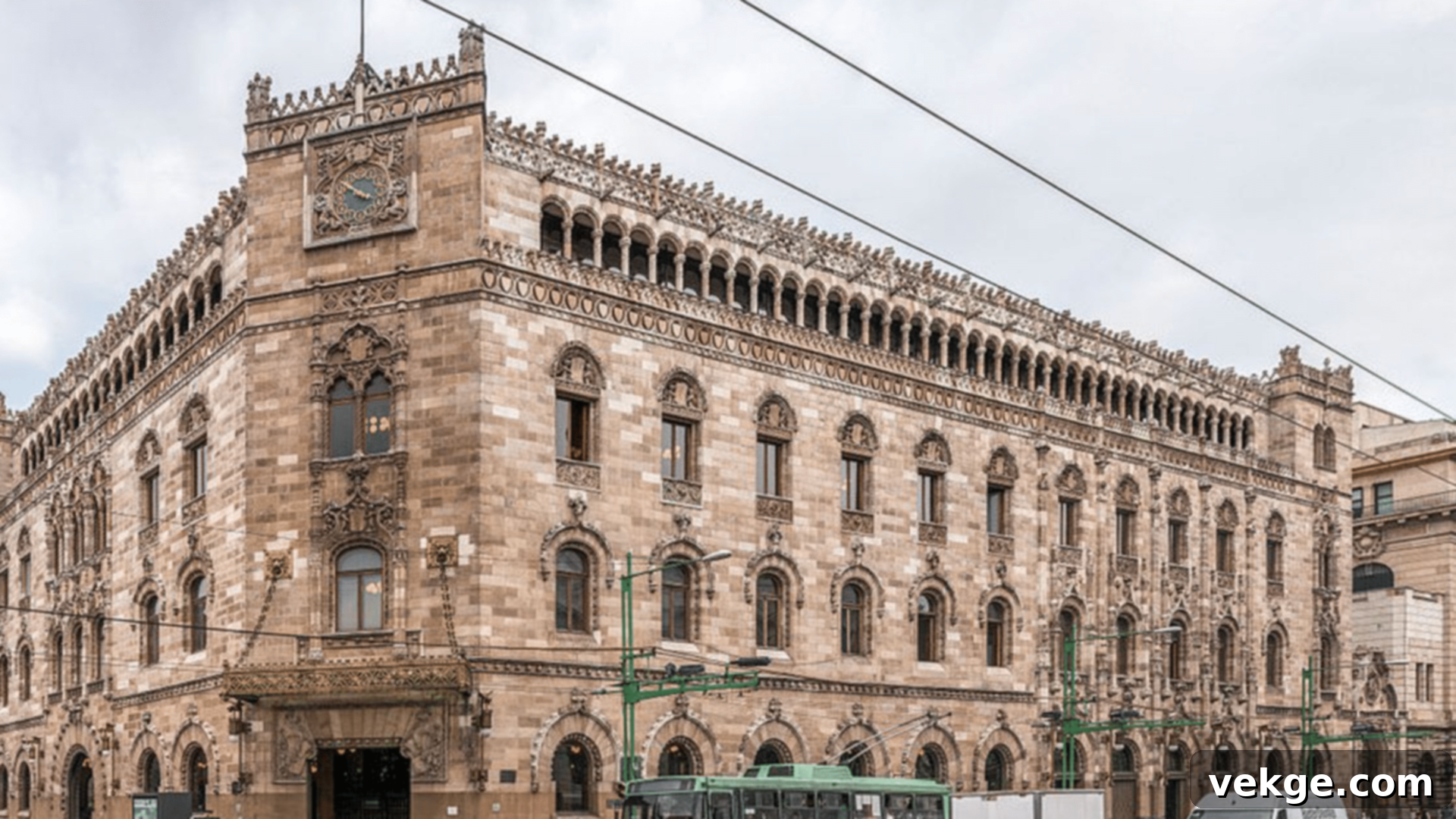
Constructed in the early 1900s during the presidency of Porfirio Díaz, the Palacio Postal is a dazzling architectural gem that perfectly encapsulates Mexico’s ambitious modernization efforts at the turn of the century. This exquisite postal palace masterfully blends elements of Italian Renaissance and Spanish Plateresque styles, creating a unique and opulent aesthetic. The building’s exterior is impressive, but its interior truly stuns visitors with a breathtaking marble staircase that spirals upwards, complemented by intricate ironwork that transforms a merely functional mail facility into a magnificent monument to progress and artistry.
Beyond its grand staircase, the Palacio Postal boasts gleaming bronze counters, meticulously detailed ceiling work, and a cavernous grand hall that continues to serve both its original postal functions and as a popular museum space for curious visitors. It stands as a testament to the era’s desire for European elegance and efficiency, meticulously adapted to a Mexican context, and remains one of Mexico City’s most beloved public buildings.
2. National Palace (Palacio Nacional), Mexico City
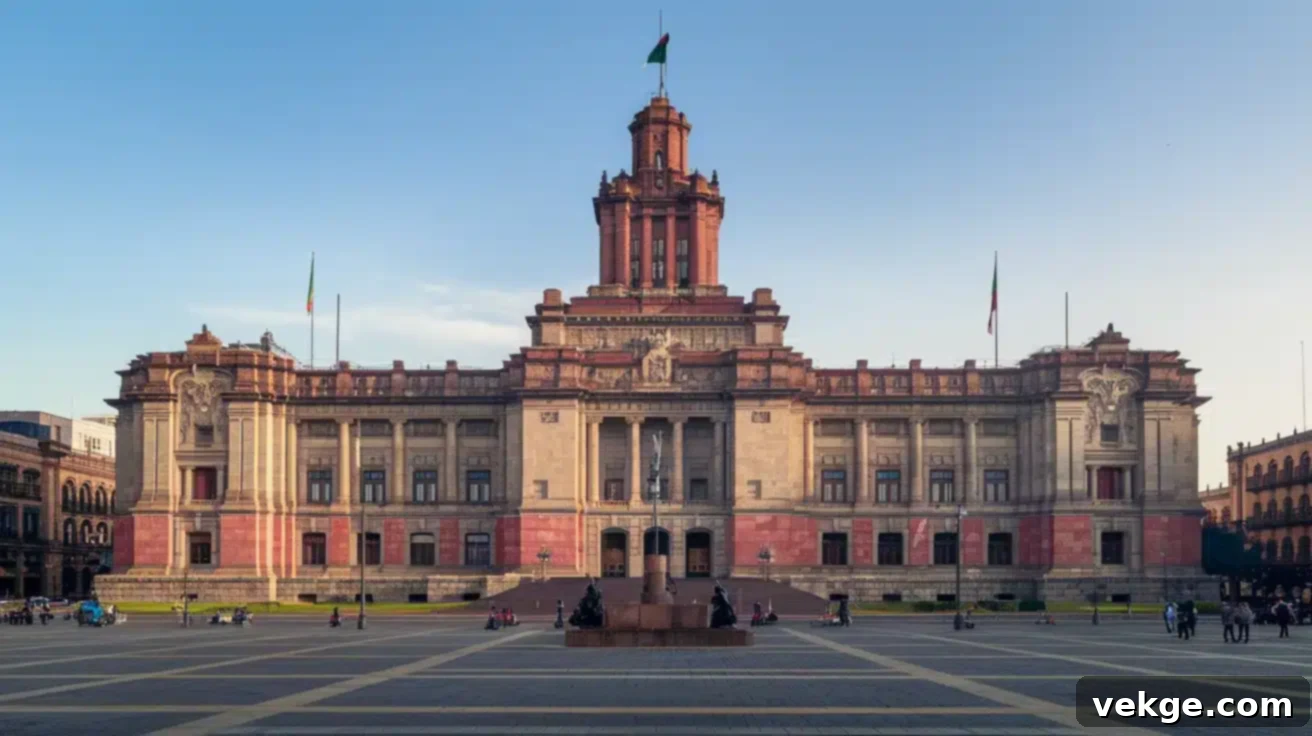
The National Palace is more than just a government building; it is a living chronicle of Mexico’s profound history, standing majestically on the very site where Moctezuma II’s palace once dominated Tenochtitlan. This strategic location creates an undeniable and potent link between Mexico’s illustrious pre-Hispanic past and its contemporary governance. Its striking red tezontle stone facade stretches impressively across the entire eastern side of the Zócalo, Mexico City’s bustling historic center, a constant visual reminder of enduring power and heritage.
Within its historic walls, visitors are greeted by the magnificent murals of Diego Rivera, which offer an expansive and vibrant visual narrative of Mexico’s complex history. These murals depict everything from the rich mythology of pre-Hispanic times to the dramatic events of the Mexican Revolution. The central staircase proudly hosts the most celebrated of these murals, presenting key moments, pivotal figures, and profound cultural themes from Mexico’s past in an unparalleled, comprehensive panorama. The National Palace is thus not merely an administrative center but a monumental canvas telling the story of a nation.
3. Casa de los Azulejos (House of Tiles), Mexico City
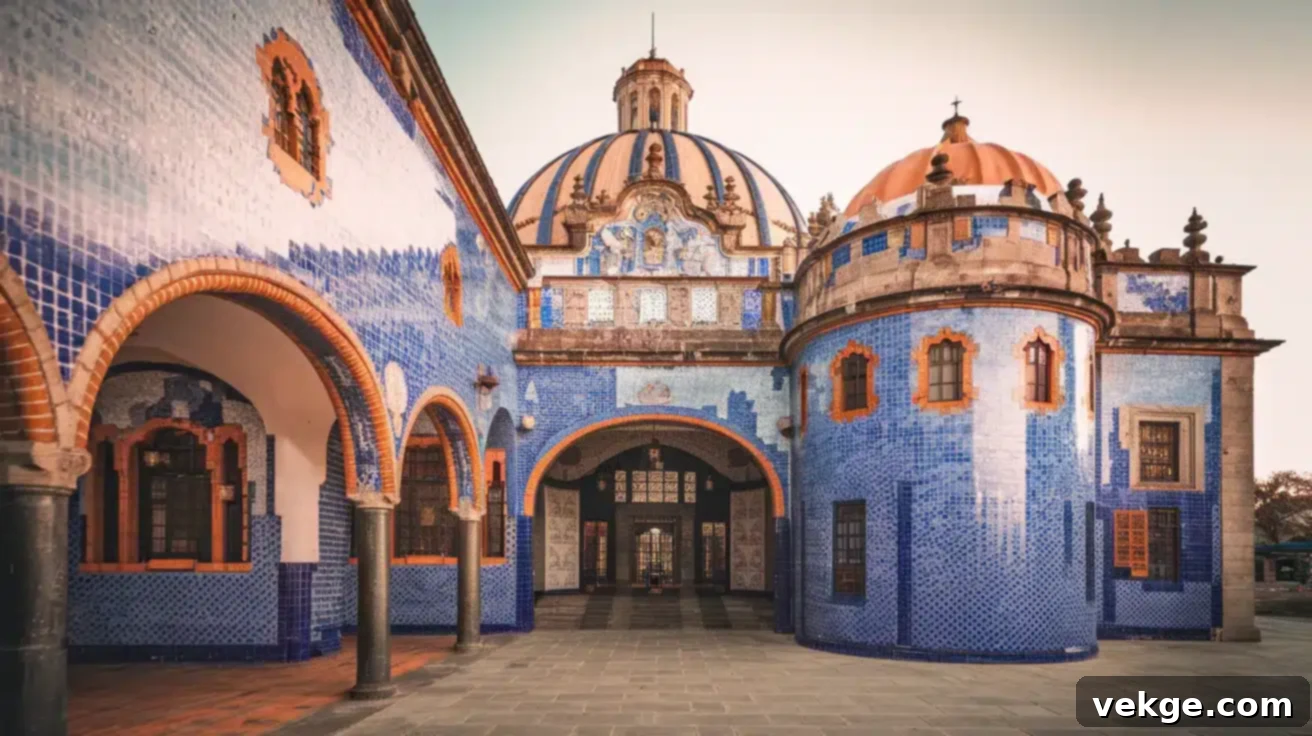
The Casa de los Azulejos, an exquisite 18th-century palace, is instantly recognizable and celebrated for its stunning exterior entirely covered in vibrant blue and white Talavera tiles sourced from Puebla. These intricately arranged tiles form mesmerizing geometric patterns that make the building a true landmark within Mexico City’s historic center. Originally commissioned and built for the aristocratic Count of the Valle de Orizaba family, the building serves as a magnificent example of how Mexican artisans skillfully adapted Spanish techniques to forge a distinct and visually captivating colonial style, infused with local materials and craftsmanship.
Today, this beautifully preserved structure houses a popular Sanborns restaurant, allowing both locals and visitors to immerse themselves in historical architecture while enjoying a meal. The ability to dine within such a significant and aesthetically rich historical setting offers a unique and tangible connection to Mexico’s artistic and social past, making it a beloved attraction.
4. Ciudad Universitaria (University City), Mexico City

The main campus of the National Autonomous University of Mexico (UNAM), known as Ciudad Universitaria, is a monumental achievement in modern architecture and urban planning. Its buildings, constructed primarily in the 1950s, ingeniously merge international modernist principles with powerful Mexican cultural elements, creating a truly unique academic environment. This sprawling academic complex justly earned UNESCO World Heritage status for its profound cultural and artistic significance, recognized globally as an outstanding example of 20th-century architecture.
The Central Library stands as the most visually striking component, with its entire exterior enveloped in magnificent mosaic murals by Juan O’Gorman. These colossal artworks incorporate a rich tapestry of pre-Hispanic symbols, historical references, and scientific imagery, transforming the building into a giant, open-air art gallery. The campus layout thoughtfully emphasizes expansive open spaces and a seamless integration with the natural landscape, even utilizing volcanic stone from the site itself in its construction. Ciudad Universitaria is a powerful symbol of Mexican national identity, intellectual pursuit, and artistic innovation.
5. Gran Hotel Ciudad de México, Mexico City
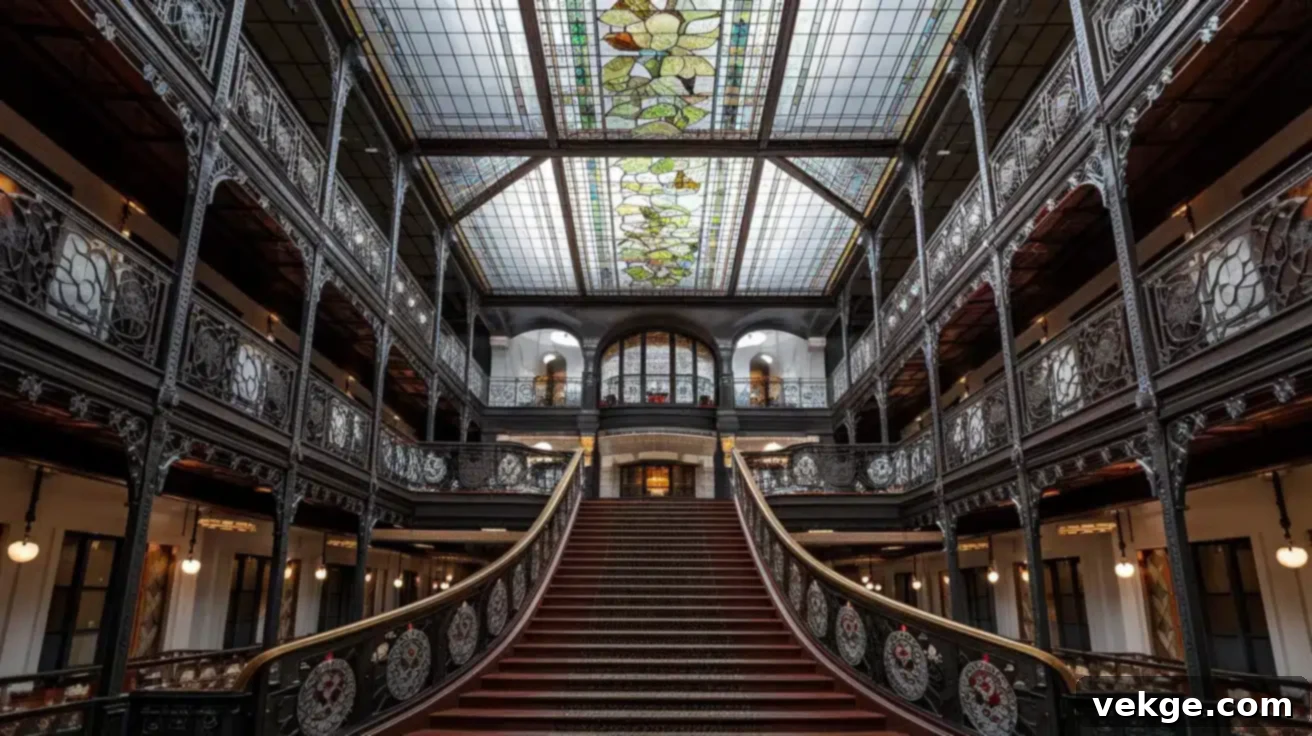
Positioned prominently on the Zócalo, the Gran Hotel Ciudad de México is a spectacular showcase of early 20th-century luxury and architectural opulence. Its most breathtaking feature is undoubtedly the colossal Tiffany stained-glass ceiling, a true masterpiece that floods the hotel’s interior with a kaleidoscope of colored light, creating an atmosphere of unparalleled grandeur. The hotel’s exquisite Art Nouveau design elements, from the ornate ironwork to the elegant detailing, contribute to an ambiance of refined sophistication and historical elegance.
The beautifully preserved wrought-iron elevators, the sweeping grand staircase, and the intricate metalwork throughout the building capture the optimism and artistic flourish of Mexico’s centennial celebration period. Originally conceived as a commercial center named El Centro Mercantil, the structure was later transformed into this magnificent hotel, offering visitors a captivating glimpse into Mexico’s belle époque, a period of cultural flourishing and European-inspired glamour. It remains a popular destination for its beauty and historical resonance.
6. Mirador Torre Latino (Latin American Tower), Mexico City
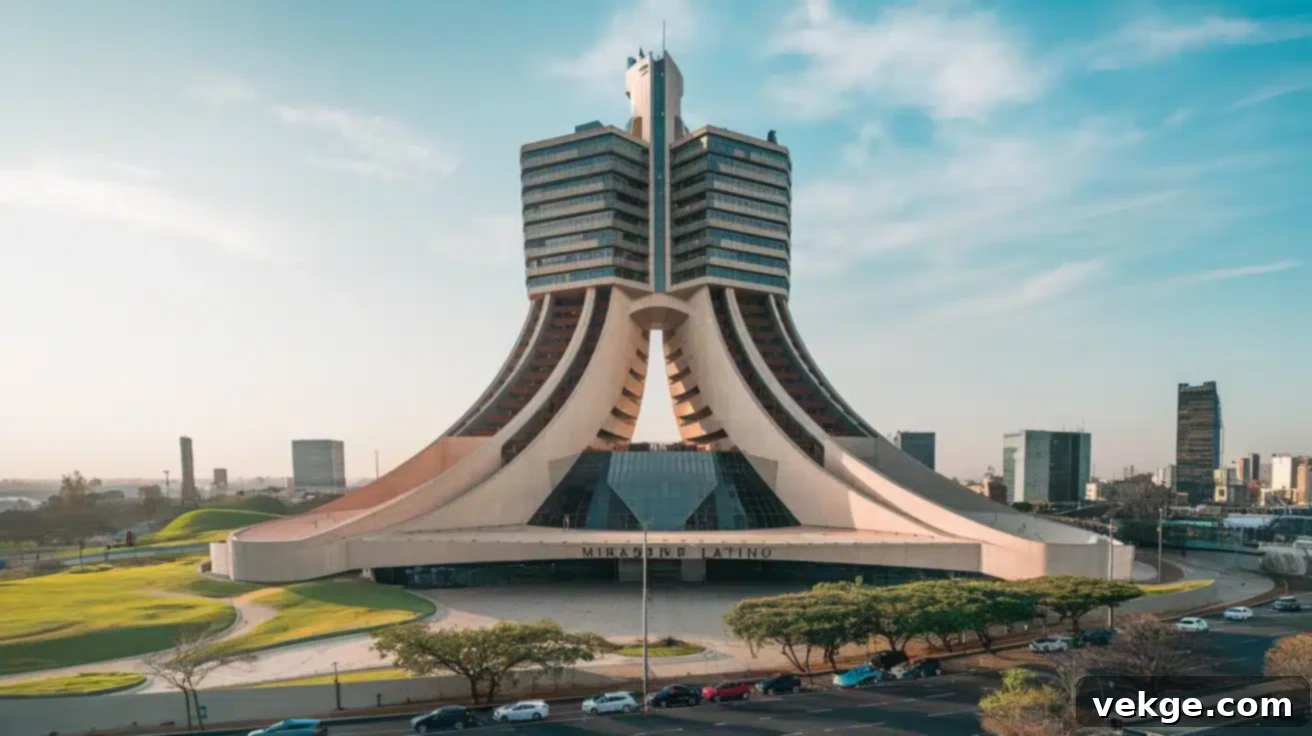
Completed in 1956, the Torre Latinoamericana was, for a time, the tallest building in Latin America and remains an iconic symbol of Mexico City’s urban landscape and engineering prowess. Its groundbreaking earthquake-resistant design proved its mettle during the devastating 1985 earthquake, when the tower famously remained standing and largely undamaged while many surrounding buildings collapsed. This resilience cemented its status as an emblem of Mexican engineering excellence and innovation, particularly given Mexico City’s challenging seismic conditions and soft soil.
The 44-story building offers a public observation deck that provides unparalleled 360-degree panoramic views of Mexico City, allowing visitors to grasp the sheer scale of the metropolis. Its clean lines and minimalist facade are a strong representation of the international modernist movement’s profound influence on Mexican architecture during a period of rapid urban development and modernization, showcasing a blend of functionality and advanced structural design.
7. Museo Nacional de Antropología (National Museum of Anthropology), Mexico City
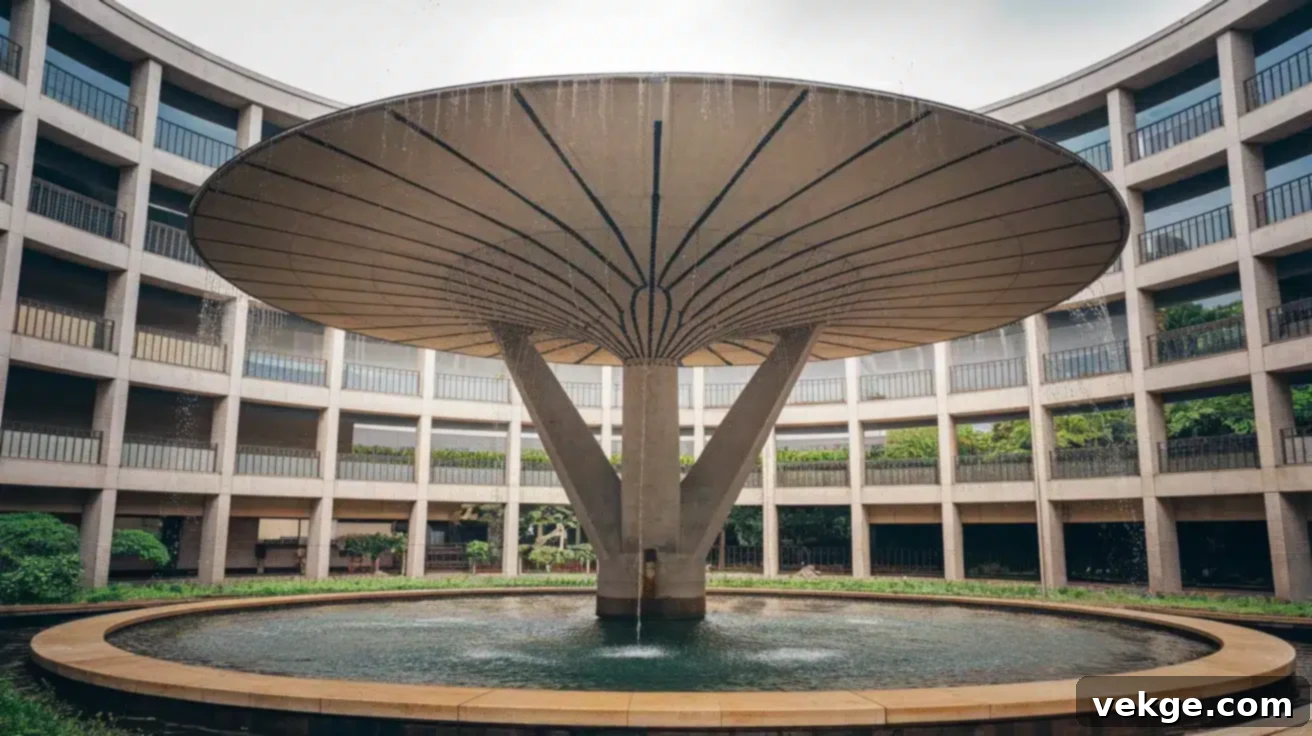
Designed by the celebrated architect Pedro Ramírez Vázquez and inaugurated in 1964, the Museo Nacional de Antropología is widely regarded as one of the world’s finest museums. Its architectural brilliance is immediately evident in its central courtyard, dominated by a monumental concrete umbrella (known as “El Paraguas”) supported by a single, slender pillar, from which a graceful cascade of water continuously flows. This dramatic feature is both aesthetically striking and symbolically significant, evoking ancient Mesoamerican rain deities.
The building masterfully organizes Mexico’s vast archaeological treasures into halls arranged by cultural regions, creating a logical and immersive visitor experience. Each gallery thoughtfully opens onto a meticulously curated garden area that recreates the natural environment of the culture being displayed, further enhancing the contextual understanding of the artifacts. The design ingeniously incorporates pre-Hispanic spatial concepts and symbolism with modern materials and construction techniques, creating a profound and ongoing dialogue between Mexico’s rich architectural past and its innovative present, making it a cornerstone of national identity and cultural preservation.
8. Parroquia de San Miguel Arcángel (Parish Church of Saint Michael Archangel), San Miguel de Allende

The Parroquia de San Miguel Arcángel is undoubtedly the most iconic landmark of San Miguel de Allende, captivating visitors with its dramatic pink cantera stone facade and soaring neo-Gothic towers. This architectural masterpiece creates one of Mexico’s most frequently photographed and instantly recognizable urban scenes. The church’s striking appearance is largely due to the remarkable vision of indigenous stonemason Zeferino Gutiérrez, who, in the late 19th century, boldly redesigned the original Baroque front. Legend has it that he drew inspiration from postcard images of European Gothic cathedrals, translating their grandeur into a distinctly Mexican context.
The church’s magnificent spires dominate the skyline, creating an undeniable focal point for the entire urban landscape of this charming colonial town. While the exterior boasts a dramatic neo-Gothic flair, the interior retains much of its original colonial character, adorned with intricate gold-leaf decoration, revered religious artwork, and traditional altarpieces, offering a fascinating contrast to the flamboyant exterior. This blend of styles makes the Parroquia a unique example of architectural evolution and local artistic interpretation.
9. Basilica of Our Lady of Guadalupe, Mexico City
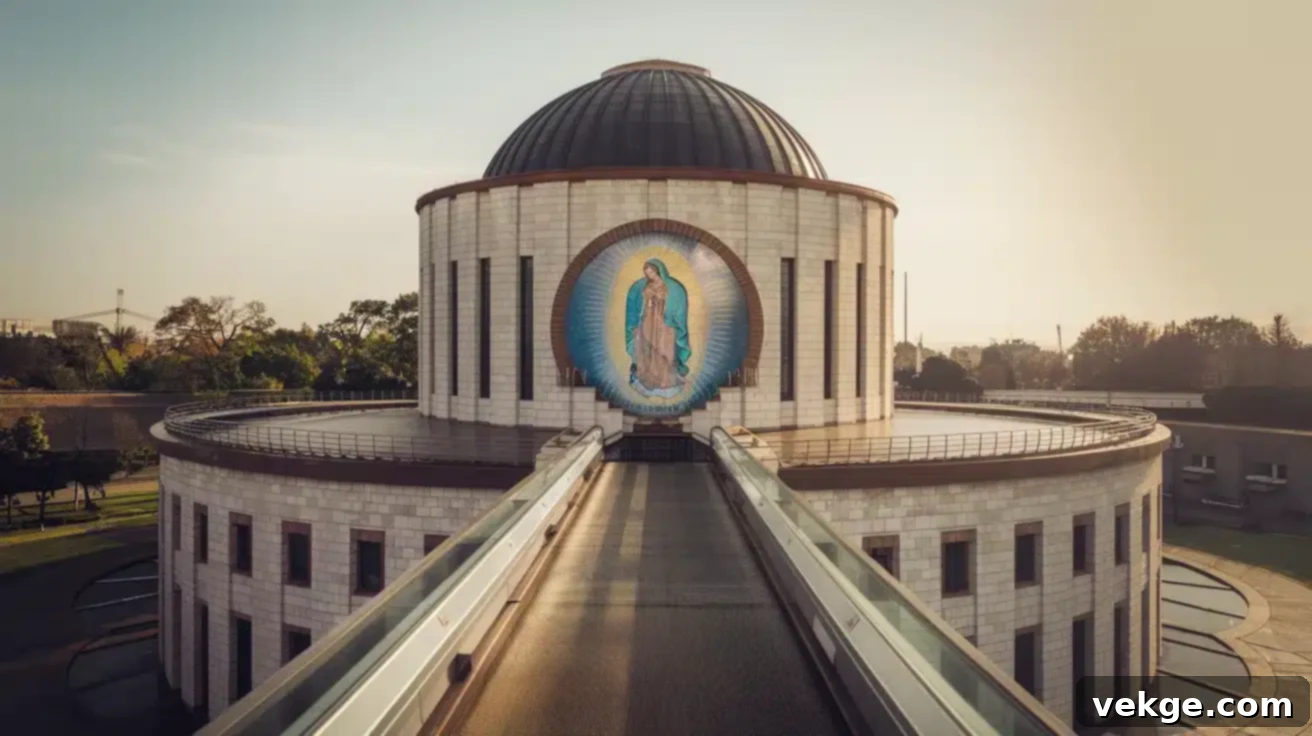
The modern circular Basilica of Our Lady of Guadalupe, completed in 1976, is an architectural marvel designed to accommodate the millions of devoted pilgrims who visit this sacred site annually, making it one of the most visited Catholic shrines in the world. Also designed by the renowned architect Pedro Ramírez Vázquez, this contemporary structure was built to address the critical issue of the older basilica sinking into Mexico City’s soft soil, a common challenge in the metropolis.
The basilica features an innovative moving walkway below the revered image of the Virgin of Guadalupe, allowing the immense crowds to view the tilma without causing congestion. Its unique circular layout ensures that the miraculous image is visible from any point within the vast interior, fostering a sense of communal worship and accessibility. Standing adjacent to the historic older structures, the new basilica exemplifies how modern architecture can successfully serve mass spiritual tourism while reverently maintaining profound sacred significance, blending functionality with deep religious devotion and a sense of continuity with the past.
10. Chichen Itza, Yucatán Peninsula

Chichen Itza, an ancient Mayan city, is one of the most significant and well-preserved archaeological sites in Mexico, renowned for its sophisticated architecture and astronomical alignments. Its centerpiece is the magnificent stepped pyramid known as El Castillo (The Temple of Kukulkan), an icon of pre-Hispanic ingenuity. During the spring and autumn equinoxes, the sun’s angle creates a mesmerizing light-and-shadow effect on the staircase, resembling a serpent undulating down the pyramid – a stunning testament to Mayan astronomical knowledge and architectural precision.
The site also encompasses the largest ball court in Mesoamerica, along with numerous other structures that showcase the advanced architectural principles of the Maya, including their innovative use of corbeled arches, precise stone cutting achieved without metal tools, and buildings ingeniously integrated with astronomical alignments and unique acoustic effects. This UNESCO World Heritage site offers profound insights into pre-Hispanic urban planning, engineering, and the intricate integration of architecture with religious practices and cosmological beliefs, making it an indispensable window into ancient civilizations.
11. Palacio de Bellas Artes (Palace of Fine Arts), Mexico City
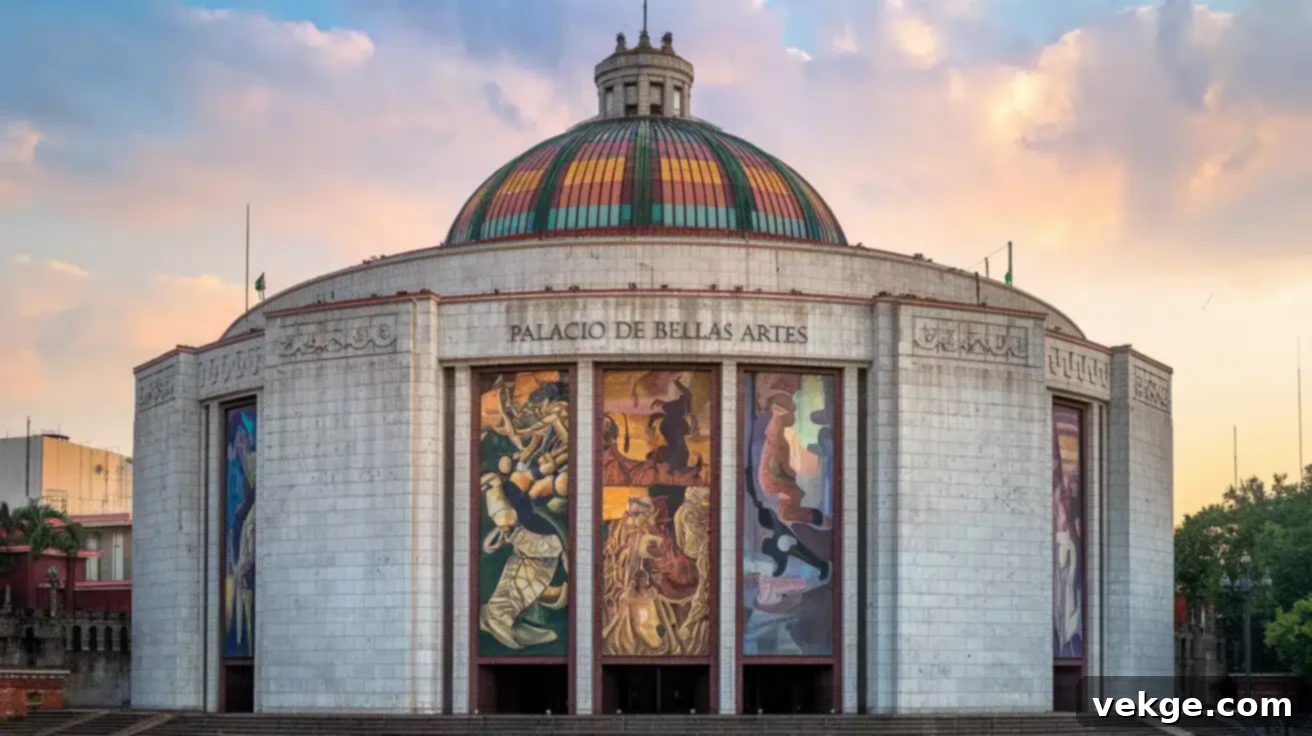
The Palacio de Bellas Artes stands as Mexico City’s premier cultural center, an architectural masterpiece that beautifully bridges two distinct yet complementary styles: an opulent Art Nouveau exterior seamlessly transitions into a glamorous Art Deco interior. This stylistic fusion perfectly reflects its protracted construction period, which spanned from 1904 to 1934, marked by the Mexican Revolution and subsequent artistic movements. Its dazzling white marble facade, imported from Italy, and its vibrant, colorful tiled dome create an unmistakable and majestic presence in the heart of Mexico City’s historic center.
Within its magnificent interior spaces are housed some of Mexico’s most important murals by revered artists, including Diego Rivera, David Alfaro Siqueiros, and José Clemente Orozco, depicting powerful themes of Mexican history and identity. The main auditorium features a truly unique Tiffany stained-glass curtain, depicting the stunning Valley of Mexico, an artistic marvel in itself. The Palacio de Bellas Artes serves as Mexico’s principal venue for performing arts, exhibitions, and cultural events, solidifying its role as a beacon of national artistic expression and heritage.
12. Cuadra San Cristóbal, Mexico City

Cuadra San Cristóbal is an iconic residential compound designed by the legendary architect Luis Barragán in the 1960s, a profound expression of his mature architectural style. Located in Mexico City, this private residence and stable complex is renowned for its striking, minimalist pink walls, tranquil water features, and the masterfully considered interplay of light and shadow. Barragán’s work here transcends mere aesthetics; it delves into creating emotional and spiritual experiences through space.
The property brilliantly demonstrates how color functions as a fundamental structural and emotional element, with massive, unadorned pink walls creating distinct spatial divisions and evoking powerful emotional responses. Reflective water features add dynamic movement and soothing sound to the architectural experience, blurring the lines between built environment and nature. Barragán’s revolutionary use of color, light, and water earned him international recognition, culminating in the prestigious Pritzker Architecture Prize in 1980, firmly establishing his legacy as one of the 20th century’s most influential architects.
13. Templo Mayor (Main Temple), Mexico City
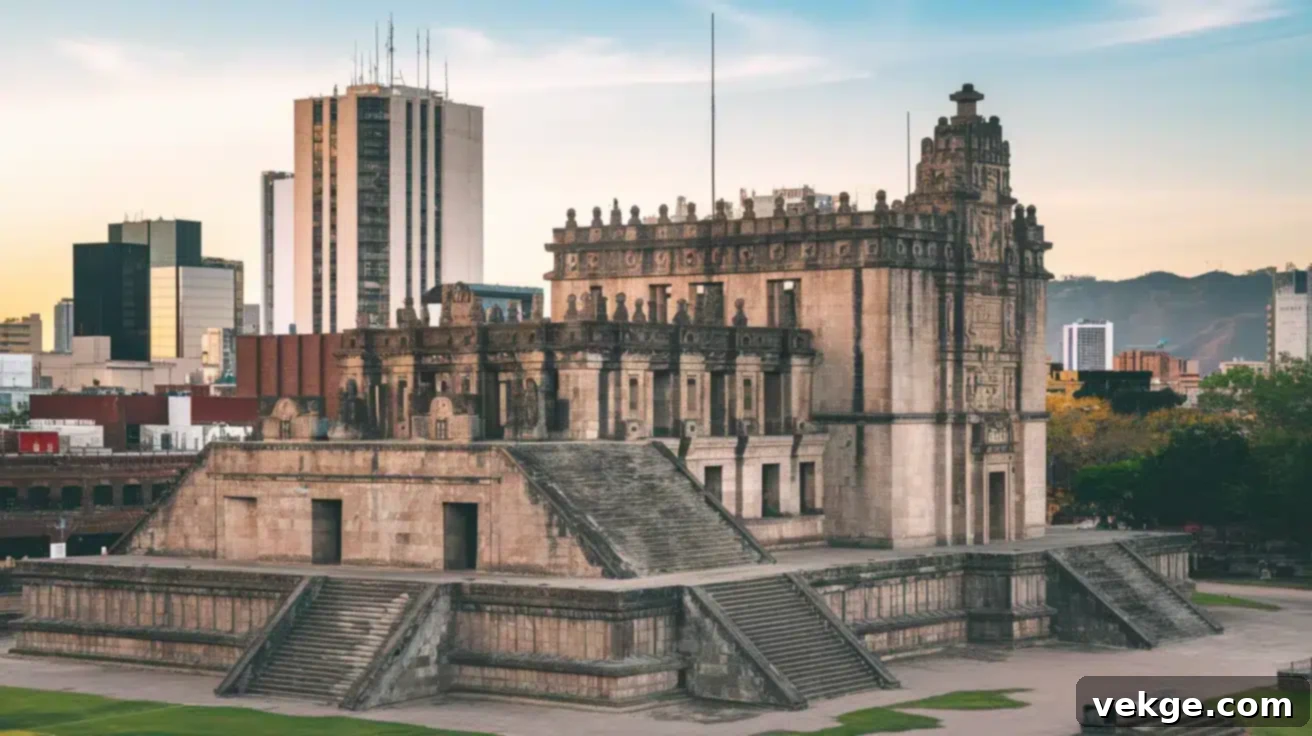
The ruins of the Templo Mayor, painstakingly excavated in the 1970s, reveal the awe-inspiring main Aztec temple that once stood at the spiritual and political heart of Tenochtitlan, the magnificent capital of the Aztec Empire, now modern-day Mexico City. This remarkable archaeological site provides invaluable insight into Aztec cosmology and construction methods, showcasing how the Aztecs ceremonially built increasingly larger temples directly on top of older structures, with each new layer commemorating different periods of their civilization and expanding the sacred precinct.
The adjacent museum houses an extraordinary collection of artifacts discovered during the excavations, including sacrificial offerings, intricate sculptures, and everyday items that illuminate the daily life and religious practices of the Aztecs. The Templo Mayor’s location, directly beside the imposing Metropolitan Cathedral, creates a powerful physical juxtaposition of pre-Hispanic and Spanish religious architecture. This serves as a poignant and enduring symbol of the cultural layering that defines Mexican history, where ancient roots lie beneath colonial legacies, telling a complex story of conquest, syncretism, and enduring heritage.
14. La Casa Estudio Diego Rivera y Frida Kahlo (Diego Rivera and Frida Kahlo House Studio), Mexico City
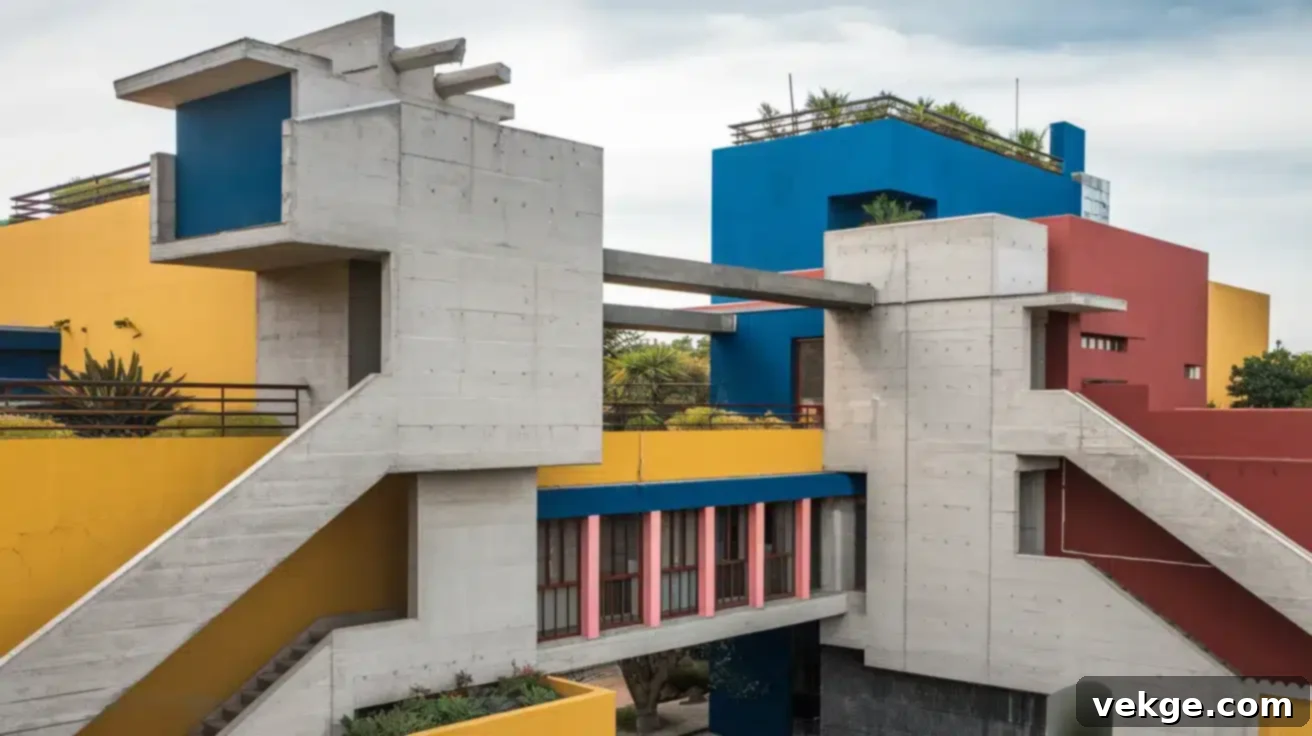
Designed by the innovative architect Juan O’Gorman, La Casa Estudio is a pioneering example of functionalist architecture in Mexico, conceived as separate yet connected studio-homes for the iconic artists Diego Rivera and Frida Kahlo. Constructed in the early 1930s, it represents one of Mexico’s earliest and most significant expressions of the functionalist movement, prioritizing utility and efficiency in design. The architecture is distinctive, featuring prominent external staircases, practical roof gardens, and bold, vibrant colors that ingeniously balance modernist principles with traditional Mexican visual aesthetics.
The buildings were meticulously designed to serve as both living and highly functional working spaces for the artists. Rivera’s studio, in particular, boasts expansive north-facing windows that provided abundant natural light, ideal for his large-scale mural painting. This architectural marvel not only housed two of Mexico’s most celebrated artists but also encapsulated a revolutionary approach to residential design, blending art, life, and architectural innovation in a cohesive and inspiring manner.
15. Museo Frida Kahlo (Frida Kahlo Museum), Mexico City
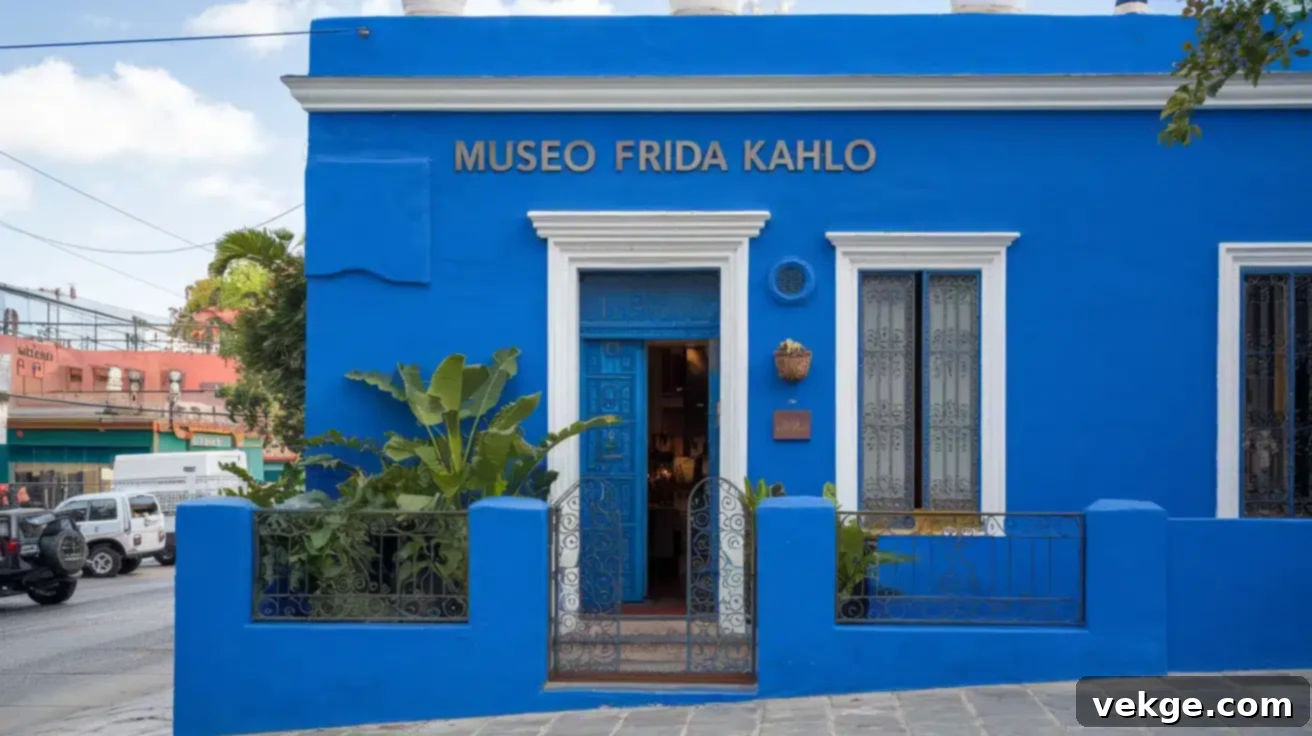
Affectionately known as the “Blue House” (La Casa Azul), the Museo Frida Kahlo is far more than just a museum; it is the vibrant, poignant structure that served as Frida Kahlo’s birthplace, childhood home, and final resting place. This intensely personal space is a powerful extension of the artist herself, characterized by its striking blue exterior walls that have become instantly recognizable and synonymous with Kahlo’s artistic identity and legacy. The building’s design adheres to traditional Mexican residential patterns, featuring intimate interior courtyards and lush garden spaces.
These areas are not merely decorative but are filled with pre-Hispanic artifacts, folk art, and personal items that profoundly inspired Kahlo’s unique artistic vision. The preserved home and workshop offer an intimate glimpse into her world, including her studio, bedroom, and the collections that fuelled her creativity. La Casa Azul powerfully demonstrates how traditional Mexican architecture could be adapted and imbued with personal meaning by 20th-century artists, creating a space that continues to resonate with visitors, offering deep insight into Kahlo’s life, art, and the cultural landscape that shaped her.
16. Palacio de los Deportes (Palace of Sports), Mexico City
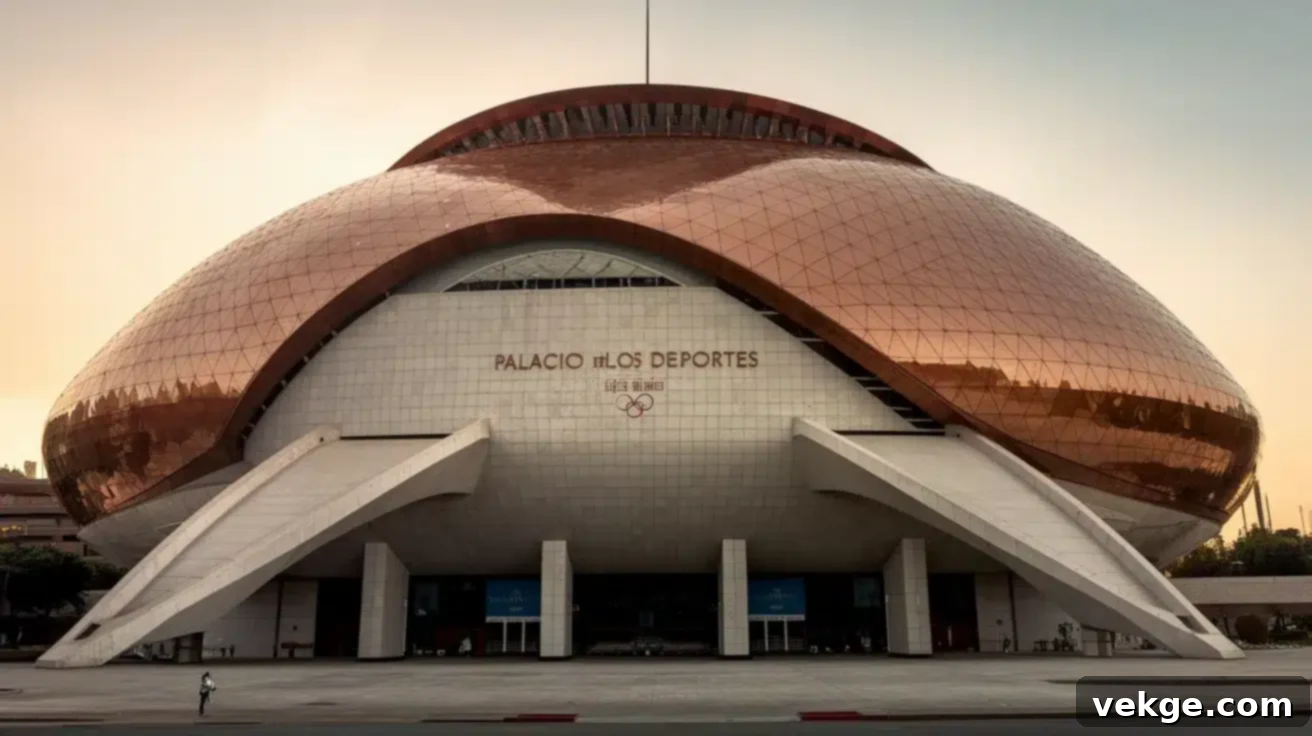
The Palacio de los Deportes, a distinctive copper-domed sports arena, was a groundbreaking architectural achievement built for the 1968 Olympic Games held in Mexico City. Its most striking feature is its unique geodesic design, conceived by the visionary architect Félix Candela, celebrated for his mastery of thin-shell concrete structures. The building’s characteristic shape, often likened to an armadillo or a giant turtle shell, allows for a vast, column-free interior space capable of accommodating an impressive 22,000 spectators, providing unobstructed views of events.
The structure brilliantly demonstrates Candela’s expertise in creating elegant and efficient large-span concrete shells, pushing the boundaries of engineering and aesthetics. Over time, the copper exterior has developed a beautiful green patina, naturally integrating the futuristic structure with its more traditional surroundings. This innovative design attracted considerable global attention to Mexican architectural and engineering capabilities during the 1968 Olympics, solidifying its place as a modernist icon and a testament to structural ingenuity.
How Architecture Varies by Region: A Tapestry of Local Identities
Mexican architecture is a vivid reflection of the country’s incredibly diverse geography, rich cultural heritage, and varied historical trajectories. Regional architectural styles did not develop by chance; they evolved over centuries through ingenious adaptation to local materials, unique climate conditions, deeply ingrained indigenous practices, and specific historical influences. This dynamic interplay has resulted in the creation of distinct architectural identities across the nation, each telling a story of its particular place.
Oaxaca: Indigenous Roots & Colonial Grandeur
Oaxacan architecture is a captivating blend where ancient indigenous traditions gracefully fuse with the enduring influences of Spanish colonial styles. Buildings in this region frequently feature the distinctive green cantera stone, a local quarry material, which is often intricately carved with geometric patterns that echo ancient Zapotec design principles. Broad corridors, deep eaves, and expansive inner courtyards are common adaptive features, thoughtfully designed to provide shade and natural ventilation, perfectly suited for the warm, semi-arid climate.
The magnificent Santo Domingo de Guzmán church and former monastery in Oaxaca City stands as a prime example, showcasing a lavish Baroque style embellished with unmistakable indigenous artistic touches, creating a unique syncretic aesthetic. Contemporary construction in Oaxaca continues this proud tradition, often incorporating traditional materials and forms, thereby forging a seamless connection between the past and present architectural landscape, deeply rooted in its local identity.
Yucatán: Maya Heritage & Tropical Adaptation
Yucatán architecture boasts a profound and undeniable connection to its ancient Maya heritage, evident in both its archaeological sites and modern constructions. Ancient Mayan sites, such as Uxmal and Kabah, feature breathtaking limestone structures adorned with intricate carvings and precisely aligned with astronomical phenomena. The colonial haciendas of the region expertly adapted European designs to the challenging tropical conditions, characterized by high ceilings, thick walls for insulation, and expansive verandas to capture cooling breezes.
Mérida’s historic center proudly displays elegant, French-influenced mansions from the opulent henequen boom era, showcasing neoclassical and Art Nouveau styles. Modern buildings in Yucatán ingeniously maintain traditional cooling features like elevated ceilings, strategic cross-ventilation, and lush interior gardens, while also consciously incorporating subtle Maya design principles, celebrating a continuous architectural lineage that respects both history and environment.
Central Highlands: Baroque Splendor & Revolutionary Spirit
The Central Highlands of Mexico are renowned for their stunning Baroque and Churrigueresque churches, which dominate city skylines with their incredibly ornate facades, lavishly carved stonework, and often gilded interiors. Urban planning in this region meticulously follows the Spanish colonial model, with life revolving around grand main plazas (zocalos) that serve as communal and administrative centers. The prevalent use of red tezontle and cantera stone creates rich, textured streetscapes that are both visually appealing and historically resonant.
The immense mining wealth generated in cities like Guanajuato funded the construction of these magnificent, grandiose structures. Post-revolutionary muralism, a powerful artistic movement, adorns many public buildings, narrating Mexico’s struggle for identity and social justice. Furthermore, Mexico City’s Ciudad Universitaria within this region represents a significant leap into mid-20th century modernism, blending functional design with monumental art, showcasing the diverse architectural evolution of the Central Highlands.
Baja California: Desert-Friendly Modernism
Architecture in Baja California is a testament to sensitive design, meticulously responding to its unique arid coastal environment. The prevailing style leans towards minimalist and contemporary designs that harmoniously complement the rugged desert landscape and expansive ocean views. Sustainable building practices are paramount, incorporating passive solar orientation to minimize heat gain and natural ventilation systems to maintain comfortable indoor temperatures.
A strong emphasis is placed on blurring the lines between indoor and outdoor living, with large windows, sliding glass doors, and expansive patios that seamlessly capture breathtaking ocean vistas and embrace the outdoors. Materials are carefully selected for their durability against marine conditions and their ability to minimize heat absorption. Contemporary designs in Baja California strike a delicate balance between luxury and environmental sensitivity, reflecting a modern approach to living in this unique and beautiful ecosystem, often featuring sleek lines and a strong connection to nature.
Preserving Mexico’s Architectural Heritage: A Collective Effort
Mexico’s invaluable historic buildings, from ancient ruins to colonial churches, face a complex array of challenges, including the relentless forces of humidity, the corrosive effects of coastal salt, and the ever-present threat of seismic activity. Beyond these environmental pressures, limited funding for conservation and rapid, often uncontrolled, urban growth add significant strain, jeopardizing the integrity of these cultural treasures. Protecting this rich architectural legacy is a monumental and ongoing task that requires innovative solutions and unwavering dedication.
Dedicated conservation teams in Mexico employ a sophisticated blend of traditional preservation methods and cutting-edge modern technology. Techniques like 3D scanning, for instance, are now crucial for accurately assessing structural damage, mapping deterioration, and planning meticulous repairs. Local communities play an indispensable role in these preservation efforts, often rallying support through educational programs that raise awareness and foster a sense of stewardship. Furthermore, robust government protections, often enacted through institutions like INAH (National Institute of Anthropology and History), and international recognition from UNESCO provide crucial additional resources, expertise, and global attention to these significant sites.
Despite persistent financial constraints, the collaborative spirit between public institutions, private organizations, and deeply committed local residents ensures that these irreplaceable cultural treasures are not only preserved but continue to thrive for the enrichment of future generations, acting as a living link to Mexico’s glorious past and its enduring identity.
Conclusion: Mexico’s Lasting Architectural Legacy
Mexico’s architectural legacy stands as a profoundly influential force, not just within its borders but on the global design stage. The dynamic fusion of indigenous wisdom, European colonial grandeur, and innovative modern styles has given birth to a truly unique visual language that resonates deeply and is reflected in built environments across the world. Mexican concepts, such as the integral role of central courtyards in urban design, the expressive and emotional use of vibrant color palettes, and the sophisticated understanding of spatial flow, have significantly shaped international architecture.
These powerful influences are not confined to historical periods; they appear prominently in contemporary design across continents, demonstrating the enduring relevance and adaptability of Mexican architectural principles. As Mexican architectural heritage continues to gain well-deserved international recognition and appreciation, its impact undeniably grows, inspiring a new generation of architects and designers to explore and incorporate its timeless principles into their own work. The ongoing and dedicated protection of these magnificent historic structures is paramount. It ensures that future generations can not only learn from but also build upon this extraordinarily rich tradition, which continues to shape and enrich our global built environment, a testament to Mexico’s enduring creative spirit.
Frequently Asked Questions About Mexican Architecture
What are some common names for Mexican architectural styles?
Mexican architecture encompasses a vibrant spectrum of styles, reflecting the country’s diverse cultural heritage. Common names include Pre-Columbian (referring to ancient indigenous structures like Mayan and Aztec pyramids), Spanish Colonial (a dominant style from the 16th to 19th centuries), Neocolonial (a revival of colonial aesthetics), Pueblo Revival and Mission Revival (popular in the Southwestern United States, drawing heavily from Mexican colonial and traditional forms), and Mexican Modernism (a 20th-century movement characterized by bold forms, color, and cultural integration). Each style tells a unique part of Mexico’s architectural story, often blending influences in fascinating ways.
What is arguably the most famous building in Mexico?
While many buildings vie for this title, the Pyramid of the Sun at Teotihuacan is widely considered Mexico’s most famous and iconic building. This massive ancient structure, dating back to around 200 CE, is one of the largest pyramids in Mesoamerica and a central feature of the ancient city of Teotihuacan. Its imposing scale, historical significance as a major ritual center, and enduring mystery make it a global symbol of Mexico’s pre-Hispanic architectural genius and a must-visit site for anyone exploring the country’s past.
How has Mexican architecture evolved over time, and what are its defining characteristics?
Mexican architecture has undergone a remarkable and continuous evolution. It began with the sophisticated engineering and cosmological alignments of pre-Columbian pyramids and temples, showcasing indigenous innovation. The Spanish conquest introduced elaborate colonial churches, palaces, and public buildings, often integrating indigenous craftsmanship into European Baroque and Neoclassical styles. Following independence, a search for national identity led to styles that integrated indigenous elements more explicitly or revived colonial aesthetics, such as Neocolonialism.
The 20th century witnessed the rise of Mexican Modernism, where architects like Luis Barragán and Pedro Ramírez Vázquez fused international modernist principles with bold colors, local materials, and cultural symbolism, creating a uniquely Mexican aesthetic. Throughout this evolution, key characteristics remain: a strong connection to the land and local materials, a vibrant use of color, the importance of courtyards and indoor-outdoor spaces, and a deep sense of cultural identity interwoven into design, reflecting centuries of adaptation, fusion, and artistic expression.
The Enduring Splendor: A Deep Dive into Mexico’s Iconic Architecture
Mexico offers an extraordinary and captivating range of architectural styles, a vibrant tapestry woven across centuries of profound cultural evolution. From the mystifying ancient Mayan temples that whisper tales of forgotten civilizations to the awe-inspiring Spanish colonial churches adorned with intricate details, and the bold, innovative statements of modern design, each structure stands as a testament to a unique moment in the nation’s rich history.
Mexican buildings are much more than mere constructions; they are eloquent expressions of design mastery, cultural adaptation, and an intrinsic understanding of diverse environments and evolving social needs. The harmonious fusion of ingenious indigenous techniques with the powerful influences brought by European settlers birthed distinctive and unparalleled styles. These styles have not only shaped Mexico’s landscape but continue to inspire and influence construction and design philosophies worldwide.
This comprehensive article embarks on a journey through Mexico’s most notable structures, spanning different historical periods and diverse regions. We will highlight how these architectural marvels eloquently articulate the identity, beliefs, and aspirations of their respective communities. Through an intimate exploration of these buildings, we gain invaluable insight into Mexico’s deeply rich cultural heritage and its ongoing, significant contribution to global architectural traditions, making it a pivotal player in the world of design.
Major Architectural Styles Shaping Mexico’s Landscape
The architectural narrative of Mexico is profoundly shaped by distinct traditions, each reflecting the nation’s complex history, cultural amalgamation, and the unique characteristics of different time periods. Understanding these styles is key to appreciating the country’s diverse built environment, revealing layers of historical and artistic development.
Colonial Architecture: A Legacy of Grandeur

The arrival of the Spanish in the 16th century dramatically transformed Mexico’s urban and rural landscapes. Spanish colonial architecture, characterized by its imposing presence and elaborate ornamentation, became the dominant style across the newly conquered territories. These buildings typically feature robust, thick walls, often constructed from local materials like tezontle (a reddish volcanic stone) and cantera (quarry stone), providing both structural integrity and protection against the elements. The design also had to adapt to seismic activity in certain regions.
Central courtyards, known as patios, served as the heart of homes and public buildings, offering privacy, ventilation, and a connection to nature—a design principle that still holds relevance today. Ornate facades, often in Baroque or Churrigueresque styles, showcased intricate stonework, sculptures, and profound religious symbolism, reflecting the fervent religious devotion of the era. Mexico City’s magnificent Metropolitan Cathedral, a monumental structure built over centuries atop a sacred Aztec site, and the numerous exquisite churches found throughout Puebla, exemplify this grand style with their impressive proportions, detailed altarpieces, and masterfully carved stonework. These structures were not just places of worship but powerful symbols of colonial power and cultural dominance, often incorporating indigenous labor and artistic flair, creating a unique hybrid aesthetic.
Traditional Mexican Architecture: Rooted in the Land

Beyond the grandeur of colonial structures, traditional Mexican architecture evolved in direct response to local environments, available resources, and community needs. This style emphasizes practicality, sustainability, and a deep connection to the land and its resources. Adobe homes, with their iconic earth-toned walls, are ubiquitous in rural areas across Mexico, particularly in the arid north and central highlands. Adobe bricks, made from sun-dried earth, offer exceptional thermal properties, keeping interiors refreshingly cool in hot climates and surprisingly warm in cooler seasons, a testament to ancient building wisdom passed down through generations.
Haciendas, once sprawling agricultural estates and vital economic centers, represent another significant traditional form. These complexes often combined functional elements like production facilities (e.g., for henequen or agave) with grand residential quarters, featuring expansive courtyards, arcaded corridors, and a distinct regional character reflecting local climate and available materials. These buildings, whether humble adobe dwellings or expansive haciendas, vividly reflect Mexican family life and community values, emphasizing open spaces, communal areas, and an organic connection to the surrounding natural landscape. They embody a way of life intrinsically linked to Mexico’s diverse geography and history, demonstrating ingenuity in utilizing local resources.
Modern Mexican Architecture: Innovation and Identity

The 20th century heralded a new era for Mexican design, bringing fresh perspectives and innovative approaches that sought to define a distinct modern Mexican identity, often influenced by post-revolutionary nationalism and international design movements. Visionary architects like Luis Barragán, renowned for his “emotional architecture,” and Pedro Ramírez Vázquez, a master of monumental public works, emerged as pioneers, introducing bold colors, clean lines, and innovative uses of materials, particularly exposed concrete forms and large glass panels.
Modern Mexican buildings frequently achieve a harmonious blend of international modernist concepts with profound cultural references, creating a distinctive aesthetic that is both global and uniquely Mexican. A prime example of this synthesis is Mexico City’s iconic National Museum of Anthropology, designed by Ramírez Vázquez, which masterfully integrates pre-Hispanic architectural elements into a contemporary structure, symbolizing a bridge between past and future. Similarly, the sprawling campus of the National Autonomous University of Mexico (UNAM), a UNESCO World Heritage site, showcases monumental murals, functionalist design, and a unique integration of art and architecture, reflecting a powerful nationalistic sentiment and a commitment to education and culture. These modern masterpieces demonstrate Mexico’s ability to innovate while remaining deeply rooted in its rich artistic and historical legacy, impacting global architectural discourse.
Iconic Mexican Buildings You Must Know: Architectural Masterpieces
Mexico’s architectural landscape is a captivating blend of historical depth and creative vision, featuring structures that vividly capture different eras of the nation’s dynamic development. From ancient wonders that echo forgotten civilizations to modern marvels that push the boundaries of design, these buildings collectively tell the compelling story of Mexico through their stone, steel, and vibrant colors.
1. Palacio Postal (Postal Palace), Mexico City

Constructed in the early 1900s during the presidency of Porfirio Díaz, the Palacio Postal is a dazzling architectural gem that perfectly encapsulates Mexico’s ambitious modernization efforts at the turn of the century. This exquisite postal palace masterfully blends elements of Italian Renaissance and Spanish Plateresque styles, creating a unique and opulent aesthetic. The building’s exterior is impressive, featuring grand arches and intricate sculptural details, but its interior truly stuns visitors with a breathtaking marble staircase that spirals upwards, complemented by intricate ironwork that transforms a merely functional mail facility into a magnificent monument to progress and artistry. Adamo Boari, an Italian architect also responsible for the Palacio de Bellas Artes, was instrumental in its design, showcasing a European grandeur fit for a modernizing nation.
Beyond its grand staircase, the Palacio Postal boasts gleaming bronze counters, meticulously detailed ceiling work, and a cavernous grand hall that continues to serve both its original postal functions and as a popular museum space for curious visitors. It stands as a testament to the era’s desire for European elegance and efficiency, meticulously adapted to a Mexican context, and remains one of Mexico City’s most beloved public buildings for its unparalleled beauty and historical significance.
2. National Palace (Palacio Nacional), Mexico City

The National Palace is more than just a government building; it is a living chronicle of Mexico’s profound history, standing majestically on the very site where Moctezuma II’s palace once dominated Tenochtitlan. This strategic location creates an undeniable and potent link between Mexico’s illustrious pre-Hispanic past and its contemporary governance. Its striking red tezontle stone facade stretches impressively across the entire eastern side of the Zócalo, Mexico City’s bustling historic center, a constant visual reminder of enduring power and heritage. Over centuries, the palace has served as a viceregal residence, an imperial palace, and now the seat of the federal executive.
Within its historic walls, visitors are greeted by the magnificent murals of Diego Rivera, which offer an expansive and vibrant visual narrative of Mexico’s complex history. These colossal artworks depict everything from the rich mythology and daily life of pre-Hispanic times to the dramatic events of the conquest, the colonial era, and the Mexican Revolution. The central staircase proudly hosts the most celebrated of these murals, presenting key moments, pivotal figures, and profound cultural themes from Mexico’s past in an unparalleled, comprehensive panorama. The National Palace is thus not merely an administrative center but a monumental canvas telling the story of a nation, acting as a historical and political heart.
3. Casa de los Azulejos (House of Tiles), Mexico City

The Casa de los Azulejos, an exquisite 18th-century palace, is instantly recognizable and celebrated for its stunning exterior entirely covered in vibrant blue and white Talavera tiles sourced from Puebla. These intricately arranged tiles form mesmerizing geometric patterns that make the building a true landmark within Mexico City’s historic center. Originally commissioned and built for the aristocratic Count of the Valle de Orizaba family, the building serves as a magnificent example of how Mexican artisans skillfully adapted Spanish techniques to forge a distinct and visually captivating colonial style, infused with local materials and craftsmanship, particularly the famed Talavera pottery.
During the colonial period, the family faced social challenges for their non-noble birth, and the opulent tile work was reputedly a defiant statement of their wealth and status. Today, this beautifully preserved structure houses a popular Sanborns restaurant, allowing both locals and visitors to immerse themselves in historical architecture while enjoying a meal. The ability to dine within such a significant and aesthetically rich historical setting offers a unique and tangible connection to Mexico’s artistic and social past, making it a beloved attraction and a vibrant example of living history.
4. Ciudad Universitaria (University City), Mexico City

The main campus of the National Autonomous University of Mexico (UNAM), known as Ciudad Universitaria, is a monumental achievement in modern architecture and urban planning. Its buildings, constructed primarily in the 1950s, ingeniously merge international modernist principles with powerful Mexican cultural elements, creating a truly unique academic environment. This sprawling academic complex justly earned UNESCO World Heritage status for its profound cultural and artistic significance, recognized globally as an outstanding example of 20th-century architecture and an expression of post-revolutionary ideals for public education.
The Central Library stands as the most visually striking component, with its entire exterior enveloped in magnificent mosaic murals by Juan O’Gorman. These colossal artworks incorporate a rich tapestry of pre-Hispanic symbols, historical references, and scientific imagery, transforming the building into a giant, open-air art gallery that tells a visual history of knowledge. The campus layout thoughtfully emphasizes expansive open spaces and a seamless integration with the natural landscape, even utilizing volcanic stone from the site itself in its construction. Renowned artists like David Alfaro Siqueiros and Francisco Eppens Helguera also contributed murals, making the campus a comprehensive architectural and artistic complex. Ciudad Universitaria is a powerful symbol of Mexican national identity, intellectual pursuit, and artistic innovation.
5. Gran Hotel Ciudad de México, Mexico City

Positioned prominently on the Zócalo, the Gran Hotel Ciudad de México is a spectacular showcase of early 20th-century luxury and architectural opulence. Its most breathtaking feature is undoubtedly the colossal Tiffany stained-glass ceiling, a true masterpiece of Art Nouveau design that floods the hotel’s interior with a kaleidoscope of colored light, creating an atmosphere of unparalleled grandeur. The hotel’s exquisite Art Nouveau design elements, from the ornate ironwork to the elegant detailing, contribute to an ambiance of refined sophistication and historical elegance that transports visitors back in time.
The beautifully preserved wrought-iron elevators, a grand, sweeping staircase, and the intricate metalwork throughout the building capture the optimism and artistic flourish of Mexico’s centennial celebration period (1910), a time of great national pride and European influence. Originally conceived as a commercial center named El Centro Mercantil by French architect Jacques Graber, the structure was later transformed into this magnificent hotel. It now offers visitors a captivating glimpse into Mexico’s belle époque, a period of cultural flourishing and European-inspired glamour, making it a favorite for tourists and film sets alike.
6. Mirador Torre Latino (Latin American Tower), Mexico City

Completed in 1956, the Torre Latinoamericana was, for a time, the tallest building in Latin America and remains an iconic symbol of Mexico City’s urban landscape and engineering prowess. Its groundbreaking earthquake-resistant design proved its mettle during the devastating 1985 earthquake, when the tower famously remained standing and largely undamaged while many surrounding buildings collapsed. This resilience cemented its status as an emblem of Mexican engineering excellence and innovation, particularly given Mexico City’s challenging seismic conditions and soft, lacustrine soil. The building’s innovative foundation relies on 361 piles driven deep into the subsoil, a feat of engineering for its time.
The 44-story building offers a public observation deck that provides unparalleled 360-degree panoramic views of Mexico City, allowing visitors to grasp the sheer scale of the metropolis and understand its layout from a unique vantage point. Its clean lines and minimalist facade are a strong representation of the international modernist movement’s profound influence on Mexican architecture during a period of rapid urban development and modernization, showcasing a blend of functionality, advanced structural design, and national pride in overcoming environmental challenges.
7. Museo Nacional de Antropología (National Museum of Anthropology), Mexico City

Designed by the celebrated architect Pedro Ramírez Vázquez and inaugurated in 1964, the Museo Nacional de Antropología is widely regarded as one of the world’s finest museums, a masterpiece of modern Mexican architecture. Its architectural brilliance is immediately evident in its central courtyard, dominated by a monumental concrete umbrella (known as “El Paraguas” or “The Umbrella”) supported by a single, slender pillar, from which a graceful cascade of water continuously flows. This dramatic feature is both aesthetically striking and symbolically significant, evoking ancient Mesoamerican rain deities and the Tree of Life.
The building masterfully organizes Mexico’s vast archaeological treasures into halls arranged by cultural regions (e.g., Maya, Aztec, Oaxaca), creating a logical and immersive visitor experience. Each gallery thoughtfully opens onto a meticulously curated garden area that recreates the natural environment of the culture being displayed, further enhancing the contextual understanding of the artifacts and providing a tranquil counterpoint to the indoor exhibits. The design ingeniously incorporates pre-Hispanic spatial concepts and symbolism with modern materials and construction techniques, creating a profound and ongoing dialogue between Mexico’s rich architectural past and its innovative present, making it a cornerstone of national identity and cultural preservation.
8. Parroquia de San Miguel Arcángel (Parish Church of Saint Michael Archangel), San Miguel de Allende

The Parroquia de San Miguel Arcángel is undoubtedly the most iconic landmark of San Miguel de Allende, captivating visitors with its dramatic pink cantera stone facade and soaring neo-Gothic towers. This architectural masterpiece creates one of Mexico’s most frequently photographed and instantly recognizable urban scenes. The church’s striking appearance is largely due to the remarkable vision of indigenous stonemason Zeferino Gutiérrez, who, in the late 19th century, boldly redesigned the original Baroque front. Legend has it that he drew inspiration from postcard images of European Gothic cathedrals, translating their grandeur into a distinctly Mexican context, despite having no formal architectural training.
The church’s magnificent spires dominate the skyline, creating an undeniable focal point for the entire urban landscape of this charming colonial town, drawing the eye from various points across the city. While the exterior boasts a dramatic neo-Gothic flair, the interior retains much of its original colonial character, adorned with intricate gold-leaf decoration, revered religious artwork, and traditional altarpieces, offering a fascinating and beautiful contrast to the flamboyant exterior. This unique blend of styles makes the Parroquia a captivating example of architectural evolution and local artistic interpretation, deeply embedded in the town’s identity.
9. Basilica of Our Lady of Guadalupe, Mexico City

The modern circular Basilica of Our Lady of Guadalupe, completed in 1976, is an architectural marvel designed to accommodate the millions of devoted pilgrims who visit this sacred site annually, making it one of the most visited Catholic shrines in the world. Also designed by the renowned architect Pedro Ramírez Vázquez, this contemporary structure was built to address the critical issue of the older basilica sinking into Mexico City’s soft soil, a common challenge for many historic buildings in the metropolis. Its innovative design ensured both stability and massive capacity.
The basilica features an innovative moving walkway below the revered image of the Virgin of Guadalupe, allowing the immense crowds to view the tilma (cloak) of Juan Diego without causing congestion. Its unique circular layout, along with a sloping floor and no internal pillars, ensures that the miraculous image is visible from any point within the vast interior, fostering a sense of communal worship and accessibility. Standing adjacent to the historic older structures, which are themselves marvels of colonial architecture, the new basilica exemplifies how modern architecture can successfully serve mass spiritual tourism while reverently maintaining profound sacred significance, blending functionality with deep religious devotion and a sense of continuity with the past.
10. Chichen Itza, Yucatán Peninsula

Chichen Itza, an ancient Mayan city, is one of the most significant and well-preserved archaeological sites in Mexico, renowned for its sophisticated architecture and precise astronomical alignments. Its centerpiece is the magnificent stepped pyramid known as El Castillo (The Temple of Kukulkan), an icon of pre-Hispanic ingenuity and engineering. During the spring and autumn equinoxes, the sun’s angle creates a mesmerizing light-and-shadow effect on the staircase, resembling a serpent undulating down the pyramid – a stunning testament to Mayan astronomical knowledge and architectural precision, linking their cosmology to their built environment.
The site also encompasses the largest ball court in Mesoamerica, where ritual games were played, along with numerous other structures that showcase the advanced architectural principles of the Maya, including their innovative use of corbeled arches, precise stone cutting achieved without metal tools, and buildings ingeniously integrated with astronomical alignments (like El Caracol, the observatory) and unique acoustic effects. This UNESCO World Heritage site offers profound insights into pre-Hispanic urban planning, engineering, and the intricate integration of architecture with religious practices and cosmological beliefs, making it an indispensable window into ancient civilizations and a powerful draw for archaeologists and tourists alike.
11. Palacio de Bellas Artes (Palace of Fine Arts), Mexico City

The Palacio de Bellas Artes stands as Mexico City’s premier cultural center, an architectural masterpiece that beautifully bridges two distinct yet complementary styles: an opulent Art Nouveau exterior seamlessly transitions into a glamorous Art Deco interior. This stylistic fusion perfectly reflects its protracted construction period, which spanned from 1904 to 1934, marked by the Mexican Revolution and subsequent artistic movements. Its dazzling white marble facade, imported from Carrara, Italy, and its vibrant, colorful tiled dome create an unmistakable and majestic presence in the heart of Mexico City’s historic center, making it one of the city’s most recognizable landmarks.
Within its magnificent interior spaces are housed some of Mexico’s most important murals by revered artists, including Diego Rivera, David Alfaro Siqueiros, and José Clemente Orozco, depicting powerful themes of Mexican history and identity. The main auditorium features a truly unique Tiffany stained-glass curtain, depicting the stunning Valley of Mexico, an artistic marvel weighing 24 tons and composed of nearly a million pieces of iridescent glass. The Palacio de Bellas Artes serves as Mexico’s principal venue for performing arts, exhibitions, and cultural events, solidifying its role as a beacon of national artistic expression and heritage, and a testament to the nation’s rich artistic output.
12. Cuadra San Cristóbal, Mexico City

Cuadra San Cristóbal is an iconic residential compound designed by the legendary architect Luis Barragán in the 1960s, a profound expression of his mature architectural style, known as “emotional architecture.” Located in Mexico City, this private residence and stable complex is renowned for its striking, minimalist pink walls, tranquil water features, and the masterfully considered interplay of natural light and shadow. Barragán’s work here transcends mere aesthetics; it delves into creating emotional and spiritual experiences through meticulously crafted spaces, drawing inspiration from traditional Mexican haciendas and Mediterranean influences.
The property brilliantly demonstrates how color functions as a fundamental structural and emotional element, with massive, unadorned pink walls creating distinct spatial divisions, guiding movement, and evoking powerful emotional responses. Reflective water features add dynamic movement and soothing sound to the architectural experience, blurring the lines between built environment and nature. The complex, designed for a horse breeder, also integrates stables and riding areas seamlessly. Barragán’s revolutionary use of color, light, and water earned him international recognition, culminating in the prestigious Pritzker Architecture Prize in 1980, firmly establishing his legacy as one of the 20th century’s most influential architects whose work continues to inspire minimalist and landscape design.
13. Templo Mayor (Main Temple), Mexico City

The ruins of the Templo Mayor, painstakingly excavated in the 1970s following an accidental discovery, reveal the awe-inspiring main Aztec temple that once stood at the spiritual and political heart of Tenochtitlan, the magnificent capital of the Aztec Empire, now modern-day Mexico City. This remarkable archaeological site provides invaluable insight into Aztec cosmology and construction methods, showcasing how the Aztecs ceremonially built increasingly larger temples directly on top of older structures, with each new layer commemorating different periods of their civilization and expanding the sacred precinct, often after significant events like the accession of a new ruler.
The temple was dedicated to two principal deities: Huitzilopochtli, the god of war and sacrifice, and Tlaloc, the god of rain and fertility, represented by two shrines at its summit. The adjacent museum houses an extraordinary collection of artifacts discovered during the excavations, including sacrificial offerings, intricate sculptures (like the colossal Coyolxauhqui monolith), and everyday items that illuminate the daily life and religious practices of the Aztecs. The Templo Mayor’s location, directly beside the imposing Metropolitan Cathedral, creates a powerful physical juxtaposition of pre-Hispanic and Spanish religious architecture. This serves as a poignant and enduring symbol of the cultural layering that defines Mexican history, where ancient roots lie beneath colonial legacies, telling a complex story of conquest, syncretism, and enduring heritage.
14. La Casa Estudio Diego Rivera y Frida Kahlo (Diego Rivera and Frida Kahlo House Studio), Mexico City

Designed by the innovative architect Juan O’Gorman, La Casa Estudio is a pioneering example of functionalist architecture in Mexico, conceived as separate yet connected studio-homes for the iconic artists Diego Rivera and Frida Kahlo. Constructed in the early 1930s in the San Ángel neighborhood, it represents one of Mexico’s earliest and most significant expressions of the functionalist movement, prioritizing utility, efficiency, and honest use of materials in design, influenced by Le Corbusier. The architecture is distinctive, featuring prominent external spiral staircases, practical roof gardens, and bold, vibrant colors (including Rivera’s iconic “cactus green”) that ingeniously balance modernist principles with traditional Mexican visual aesthetics.
The buildings were meticulously designed to serve as both living and highly functional working spaces for the artists. Rivera’s studio, in particular, boasts expansive north-facing windows that provided abundant natural light, ideal for his large-scale mural painting, while Kahlo’s studio was smaller and more intimate. This architectural marvel not only housed two of Mexico’s most celebrated artists but also encapsulated a revolutionary approach to residential design, blending art, life, and architectural innovation in a cohesive and inspiring manner, serving as a museum today, preserving the artists’ legacy and O’Gorman’s vision.
15. Museo Frida Kahlo (Frida Kahlo Museum), Mexico City

Affectionately known as the “Blue House” (La Casa Azul), the Museo Frida Kahlo is far more than just a museum; it is the vibrant, poignant structure that served as Frida Kahlo’s birthplace, childhood home, and final resting place. This intensely personal space is a powerful extension of the artist herself, characterized by its striking blue exterior walls that have become instantly recognizable and synonymous with Kahlo’s artistic identity and legacy, reflecting a deep connection to Mexican folk art and her indigenous heritage. The building’s design adheres to traditional Mexican residential patterns, featuring intimate interior courtyards and lush garden spaces, creating a private oasis in the bustling Coyoacán neighborhood.
These areas are not merely decorative but are filled with pre-Hispanic artifacts, folk art, and personal items that profoundly inspired Kahlo’s unique artistic vision and served as motifs in her paintings. The preserved home and workshop offer an intimate glimpse into her world, including her studio, bedroom, and the collections that fuelled her creativity. La Casa Azul powerfully demonstrates how traditional Mexican architecture could be adapted and imbued with personal meaning by 20th-century artists, creating a space that continues to resonate with visitors, offering deep insight into Kahlo’s life, art, and the cultural landscape that shaped her, acting as a pilgrimage site for art lovers worldwide.
16. Palacio de los Deportes (Palace of Sports), Mexico City

The Palacio de los Deportes, a distinctive copper-domed sports arena, was a groundbreaking architectural achievement built for the 1968 Olympic Games held in Mexico City. Its most striking feature is its unique geodesic design, conceived by the visionary architect Félix Candela, celebrated for his mastery of thin-shell concrete structures. Candela, along with Enrique Castañeda Tamborrell and Antonio Peyrí, created a structure whose characteristic shape, often likened to an armadillo or a giant turtle shell, allows for a vast, column-free interior space capable of accommodating an impressive 22,000 spectators, providing unobstructed views of events from every seat.
The structure brilliantly demonstrates Candela’s expertise in creating elegant and efficient large-span concrete shells, pushing the boundaries of engineering and aesthetics with its hyperbolic paraboloid forms. Over time, the copper exterior has developed a beautiful green patina, naturally integrating the futuristic structure with its more traditional surroundings and the volcanic landscape of Mexico City. This innovative design attracted considerable global attention to Mexican architectural and engineering capabilities during the 1968 Olympics, solidifying its place as a modernist icon and a testament to structural ingenuity, and continues to serve as a major concert and event venue today.
How Architecture Varies by Region: A Tapestry of Local Identities
Mexican architecture is a vivid reflection of the country’s incredibly diverse geography, rich cultural heritage, and varied historical trajectories. Regional architectural styles did not develop by chance; they evolved over centuries through ingenious adaptation to local materials, unique climate conditions, deeply ingrained indigenous practices, and specific historical influences. This dynamic interplay has resulted in the creation of distinct architectural identities across the nation, each telling a unique story of its particular place and people, making Mexico a living museum of architectural innovation.
Oaxaca: Indigenous Roots & Colonial Grandeur
Oaxacan architecture is a captivating blend where ancient indigenous traditions gracefully fuse with the enduring influences of Spanish colonial styles. Buildings in this region frequently feature the distinctive green cantera stone, a local quarry material, which is often intricately carved with geometric patterns that echo ancient Zapotec design principles and symbols, creating a unique visual language. Broad corridors, deep eaves, and expansive inner courtyards are common adaptive features, thoughtfully designed to provide shade and natural ventilation, perfectly suited for the warm, semi-arid climate of the valley and surrounding mountains.
The magnificent Santo Domingo de Guzmán church and former monastery in Oaxaca City stands as a prime example, showcasing a lavish Baroque style embellished with unmistakable indigenous artistic touches in its decorations and details, creating a unique syncretic aesthetic that is both grand and deeply local. Contemporary construction in Oaxaca continues this proud tradition, often incorporating traditional materials and forms while embracing modern techniques, thereby forging a seamless connection between the past and present architectural landscape, deeply rooted in its local identity and artistic heritage.
Yucatán: Maya Heritage & Tropical Adaptation
Yucatán architecture boasts a profound and undeniable connection to its ancient Maya heritage, evident in both its archaeological sites and modern constructions. Ancient Mayan sites, such as Uxmal and Kabah, feature breathtaking limestone structures adorned with intricate carvings, precise astronomical alignments, and sophisticated rainwater collection systems—all testament to advanced engineering and cosmological understanding. The colonial haciendas of the region expertly adapted European designs to the challenging tropical conditions, characterized by high ceilings, thick walls for insulation, and expansive verandas to capture cooling breezes, often incorporating local materials like limestone and palma (palm thatch).
Mérida’s historic center proudly displays elegant, French-influenced mansions from the opulent henequen boom era (late 19th/early 20th century), showcasing neoclassical and Art Nouveau styles that reflect the region’s wealth and cosmopolitan aspirations. Modern buildings in Yucatán ingeniously maintain traditional cooling features like elevated ceilings, strategic cross-ventilation, and lush interior gardens, while also consciously incorporating subtle Maya design principles and natural materials, celebrating a continuous architectural lineage that respects both history, environment, and the unique challenges of a tropical climate.
Central Highlands: Baroque Splendor & Revolutionary Spirit
The Central Highlands of Mexico, encompassing states like Guanajuato, Querétaro, and Zacatecas, are renowned for their stunning Baroque and Churrigueresque churches, which dominate city skylines with their incredibly ornate facades, lavishly carved stonework, and often gilded interiors that speak of immense colonial wealth and religious fervor. Urban planning in this region meticulously follows the Spanish colonial model, with life revolving around grand main plazas (zocalos) that serve as communal and administrative centers, surrounded by arcaded buildings. The prevalent use of red tezontle (volcanic stone) and lighter cantera stone creates rich, textured streetscapes that are both visually appealing and historically resonant.
The immense mining wealth generated in cities like Guanajuato and Zacatecas funded the construction of these magnificent, grandiose structures, transforming them into architectural jewels. Post-revolutionary muralism, a powerful artistic movement of the 20th century, adorns many public buildings in this region, notably in Mexico City, narrating Mexico’s struggle for identity and social justice through monumental public art. Furthermore, Mexico City’s Ciudad Universitaria within this region represents a significant leap into mid-20th century modernism, blending functional design with monumental art, showcasing the diverse architectural evolution of the Central Highlands from colonial opulence to modern national expression.
Baja California: Desert-Friendly Modernism
Architecture in Baja California, particularly in the coastal areas and resort towns, is a testament to sensitive design, meticulously responding to its unique arid coastal environment. The prevailing style leans towards minimalist and contemporary designs that harmoniously complement the rugged desert landscape and expansive ocean views. This modern approach often emphasizes clean lines, simple forms, and a strong connection to nature.
Sustainable building practices are paramount, incorporating passive solar orientation to minimize heat gain, natural ventilation systems to maintain comfortable indoor temperatures, and water-wise landscaping. A strong emphasis is placed on blurring the lines between indoor and outdoor living, with large windows, sliding glass doors, and expansive patios that seamlessly capture breathtaking ocean vistas and embrace the outdoors, often featuring infinity pools. Materials are carefully selected for their durability against harsh marine conditions (salt air, strong sun) and their ability to minimize heat absorption, such as light-colored stucco or local stone. Contemporary designs in Baja California strike a delicate balance between luxury and environmental sensitivity, reflecting a modern approach to living in this unique and beautiful ecosystem, where design is integrated with the natural surroundings.
Preserving Mexico’s Architectural Heritage: A Collective Effort
Mexico’s invaluable historic buildings, from ancient ruins that span millennia to colonial churches that have witnessed centuries of devotion, face a complex array of challenges. The relentless forces of nature, including the high humidity in tropical regions, the corrosive effects of coastal salt on materials, and the ever-present threat of seismic activity in a geologically active country, constantly test the integrity of these structures. Beyond these environmental pressures, limited funding for conservation, rapid and often uncontrolled urban growth, and the simple passage of time add significant strain, jeopardizing the integrity and survival of these cultural treasures. Protecting this rich architectural legacy is a monumental and ongoing task that requires innovative solutions and unwavering dedication from multiple stakeholders.
Dedicated conservation teams in Mexico, often spearheaded by institutions like INAH (Instituto Nacional de Antropología e Historia), employ a sophisticated blend of traditional preservation methods and cutting-edge modern technology. Techniques like 3D scanning, laser mapping, and material analysis, for instance, are now crucial for accurately assessing structural damage, mapping deterioration, and planning meticulous, historically sensitive repairs. Local communities play an indispensable role in these preservation efforts, often rallying support through educational programs that raise awareness and foster a sense of stewardship and pride in their local heritage. Furthermore, robust government protections and international recognition from organizations like UNESCO provide crucial additional resources, expertise, and global attention to these significant sites, helping to fund complex restoration projects and ensure long-term sustainability.
Despite persistent financial constraints and the sheer scale of the task, the collaborative spirit between public institutions, private organizations, and deeply committed local residents ensures that these irreplaceable cultural treasures are not only preserved but continue to thrive. This collective effort allows them to serve as living links to Mexico’s glorious past and its enduring identity, inspiring new generations and contributing to a global understanding of human achievement and artistic expression.
Conclusion: Mexico’s Lasting Architectural Legacy
Mexico’s architectural legacy stands as a profoundly influential force, not just within its borders but on the global design stage. The dynamic fusion of indigenous wisdom, European colonial grandeur, and innovative modern styles has given birth to a truly unique visual language that resonates deeply and is reflected in built environments across the world. Mexican concepts, such as the integral role of central courtyards in urban design (providing light, ventilation, and a communal space), the expressive and emotional use of vibrant color palettes (often derived from natural pigments and folk art), and the sophisticated understanding of spatial flow (creating compelling sequences of experiences), have significantly shaped international architecture.
These powerful influences are not confined to historical periods; they appear prominently in contemporary design across continents, demonstrating the enduring relevance and adaptability of Mexican architectural principles, from minimalist designs inspired by Barragán to sustainable practices rooted in ancient wisdom. As Mexican architectural heritage continues to gain well-deserved international recognition and appreciation, its impact undeniably grows, inspiring a new generation of architects and designers to explore and incorporate its timeless principles into their own work. The ongoing and dedicated protection of these magnificent historic structures is paramount. It ensures that future generations can not only learn from but also build upon this extraordinarily rich tradition, which continues to shape and enrich our global built environment, a testament to Mexico’s enduring creative spirit and its profound contribution to human culture and innovation.
Frequently Asked Questions About Mexican Architecture
What are some common names for Mexican architectural styles?
Mexican architecture encompasses a vibrant spectrum of styles, reflecting the country’s diverse cultural heritage and historical periods. Common names include Pre-Columbian (referring to ancient indigenous structures like Mayan and Aztec pyramids and cities), Spanish Colonial (a dominant style from the 16th to 19th centuries, often featuring Baroque, Churrigueresque, and Neoclassical elements), Neocolonial (a revival of colonial aesthetics in the 20th century, often used to foster national identity), Pueblo Revival and Mission Revival (popular in the Southwestern United States, drawing heavily from Mexican colonial and traditional forms). Additionally, Mexican Modernism emerged in the 20th century, characterized by bold forms, vibrant color, and the integration of cultural symbolism and art, often associated with architects like Luis Barragán and Pedro Ramírez Vázquez. Each style tells a unique part of Mexico’s architectural story, often blending influences in fascinating ways to create something distinctively Mexican.
What is arguably the most famous building in Mexico?
While many buildings vie for this title, the Pyramid of the Sun at Teotihuacan is widely considered Mexico’s most famous and iconic building. This massive ancient structure, dating back to around 200 CE, is one of the largest pyramids in Mesoamerica and a central feature of the ancient city of Teotihuacan. Its imposing scale, meticulous astronomical alignment, historical significance as a major ritual center, and enduring mystery make it a global symbol of Mexico’s pre-Hispanic architectural genius. It continues to draw millions of visitors annually, offering a powerful connection to the advanced civilizations that flourished in ancient Mexico, making it a must-visit site for anyone exploring the country’s profound past and architectural marvels.
How has Mexican architecture evolved over time, and what are its defining characteristics?
Mexican architecture has undergone a remarkable and continuous evolution, shaped by distinct historical periods and cultural syntheses. It began with the sophisticated engineering and cosmological alignments of pre-Columbian pyramids and temples, showcasing indigenous innovation and an intimate understanding of their environment. The Spanish conquest introduced elaborate colonial churches, palaces, and public buildings, often incorporating indigenous craftsmanship and local materials into European Baroque, Churrigueresque, and Neoclassical styles, creating a unique syncretic aesthetic.
Following independence, a search for national identity led to styles that integrated indigenous elements more explicitly or revived colonial aesthetics, such as Neocolonialism, as seen in many public buildings and residential designs. The 20th century witnessed the rise of Mexican Modernism, where architects like Luis Barragán and Pedro Ramírez Vázquez fused international modernist principles (clean lines, functionality) with bold colors, local materials, and profound cultural symbolism, often incorporating large-scale murals and integrating indoor and outdoor spaces. Throughout this evolution, key characteristics remain: a strong connection to the land and local materials, a vibrant and expressive use of color, the importance of courtyards and seamless indoor-outdoor spaces, and a deep sense of cultural identity interwoven into the design, reflecting centuries of adaptation, fusion, and artistic expression that continue to inspire globally.
